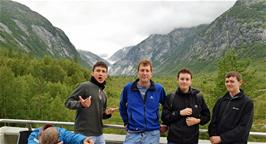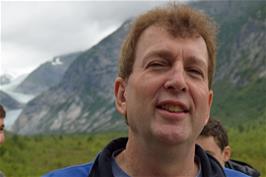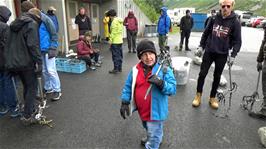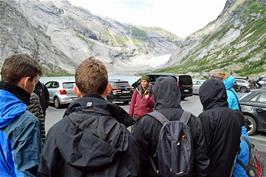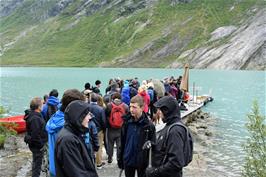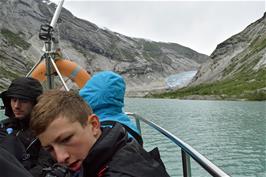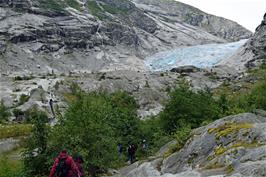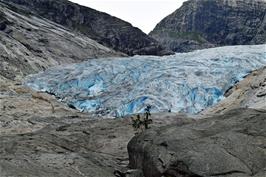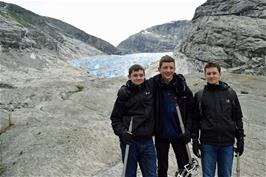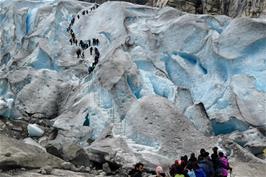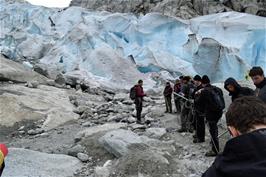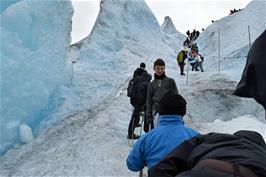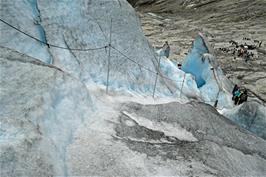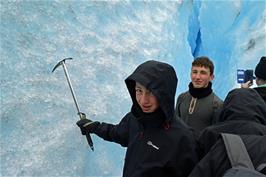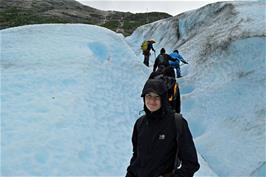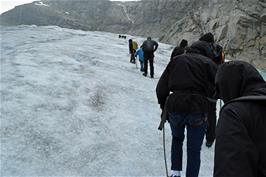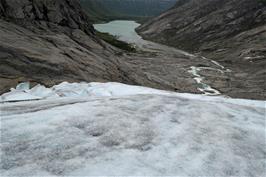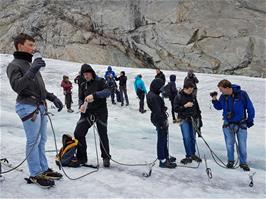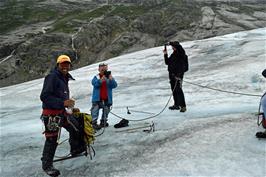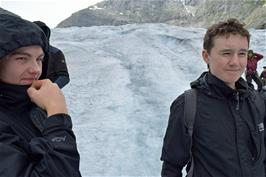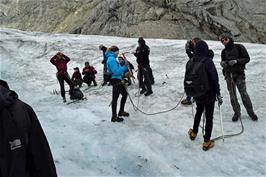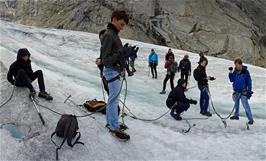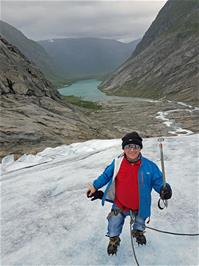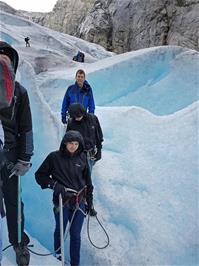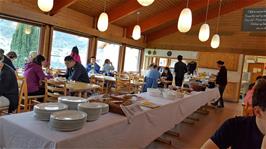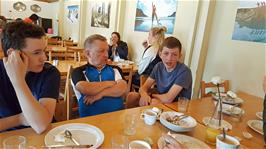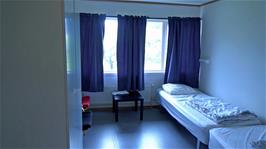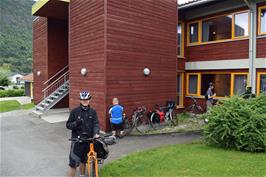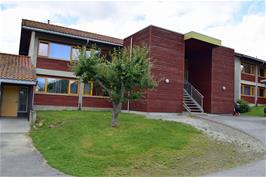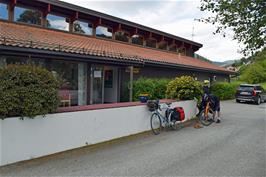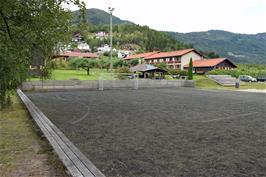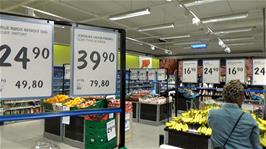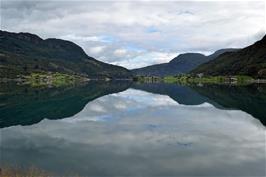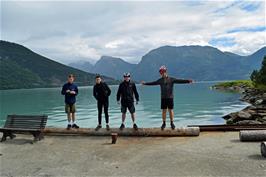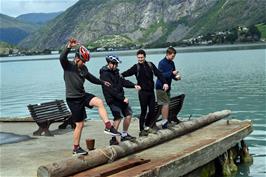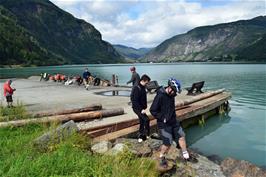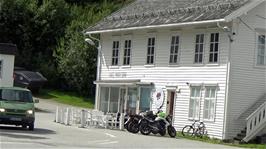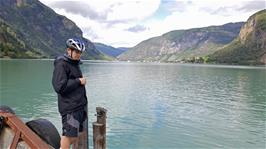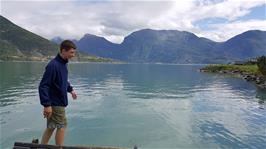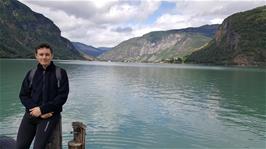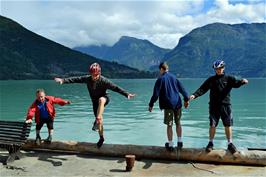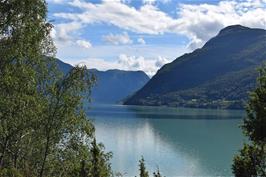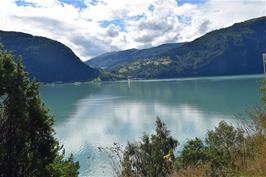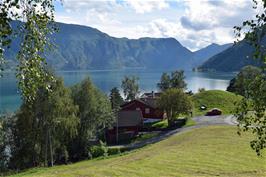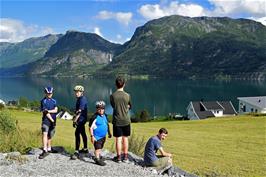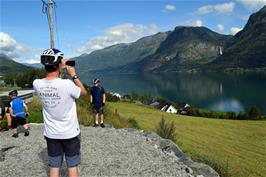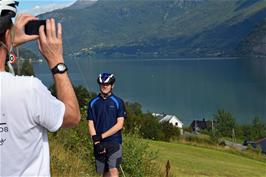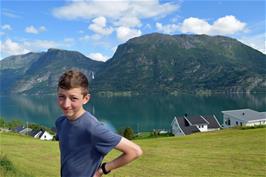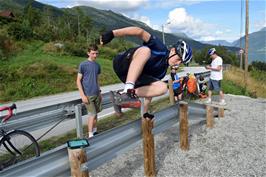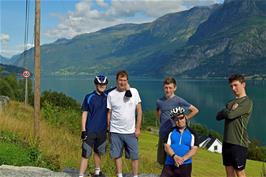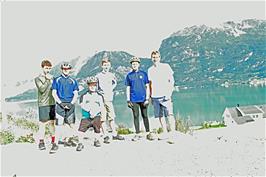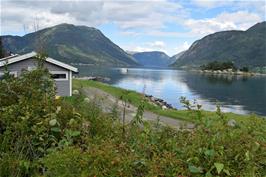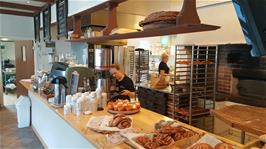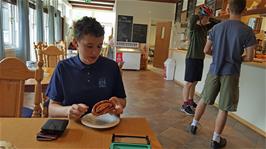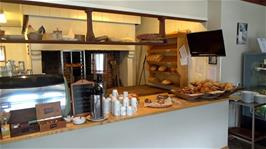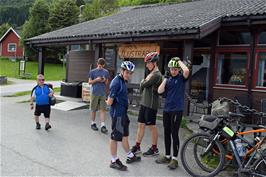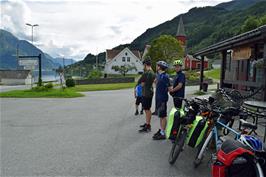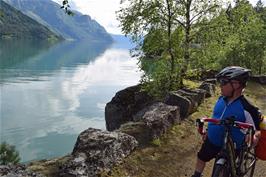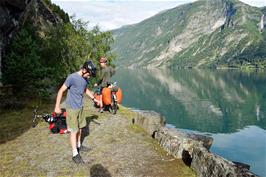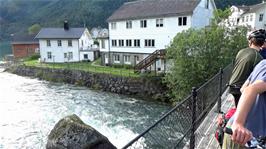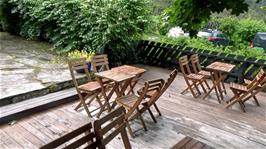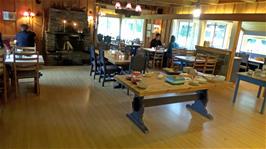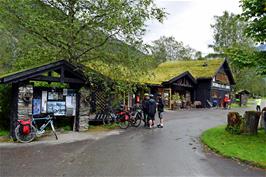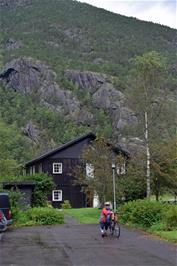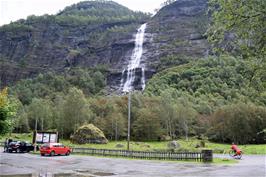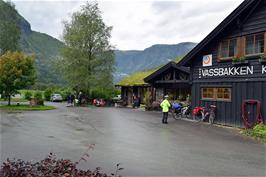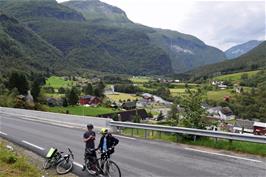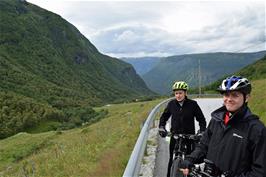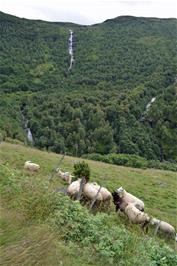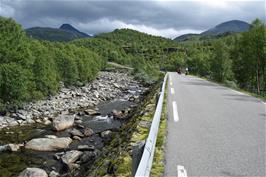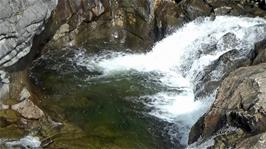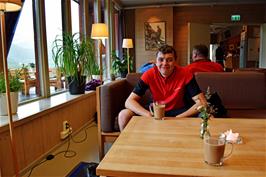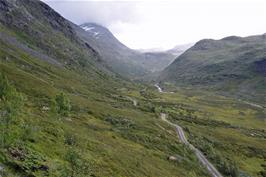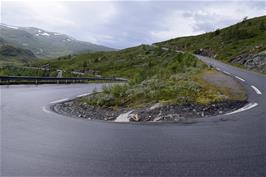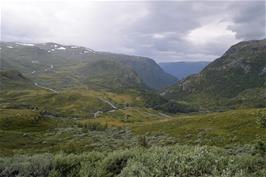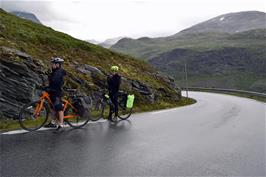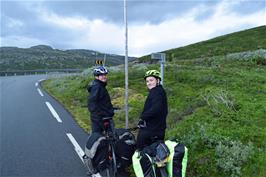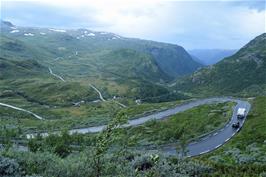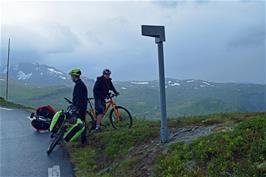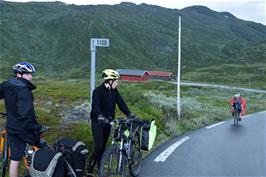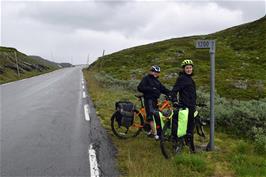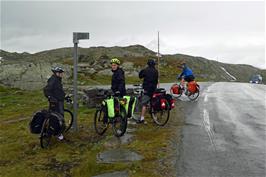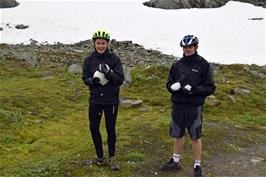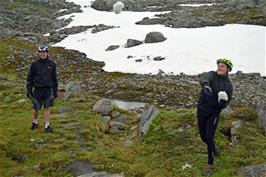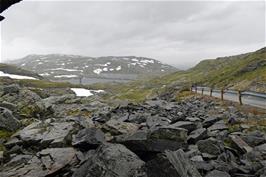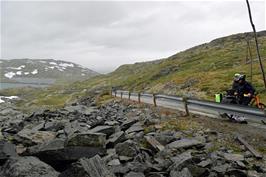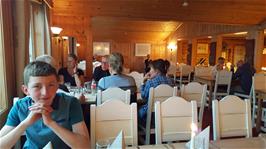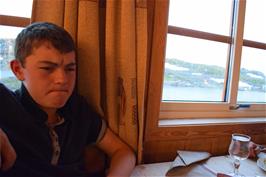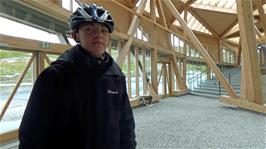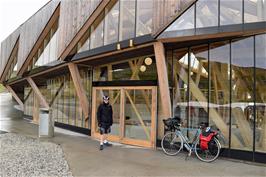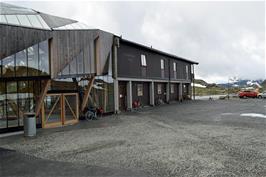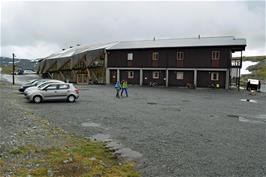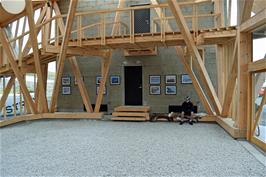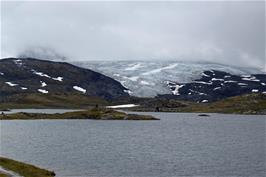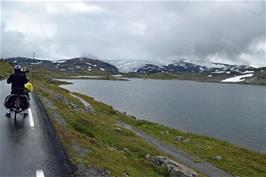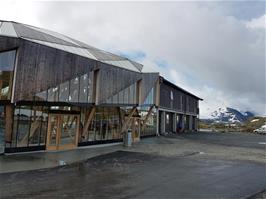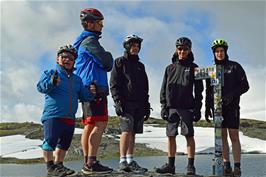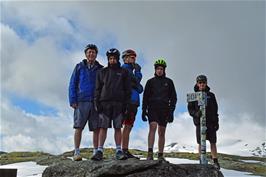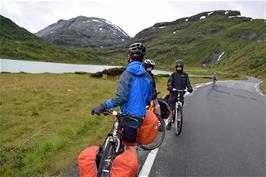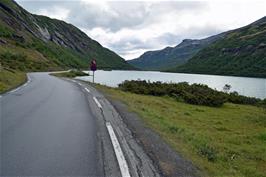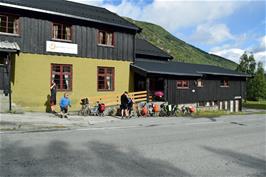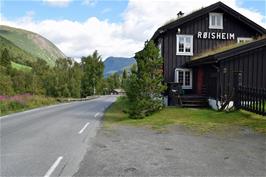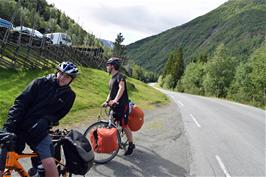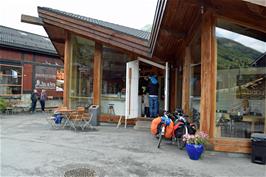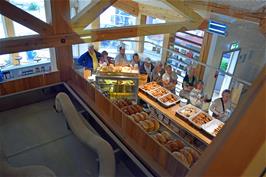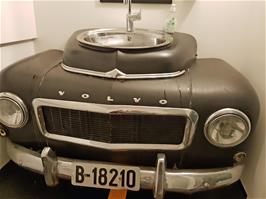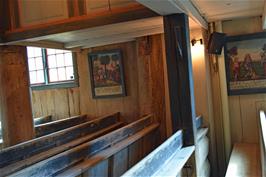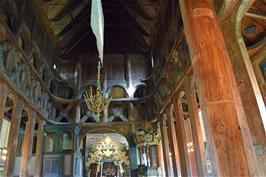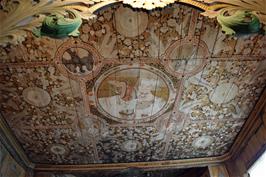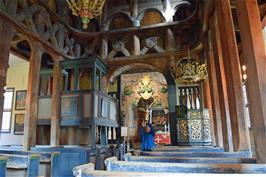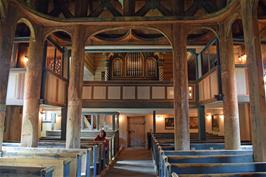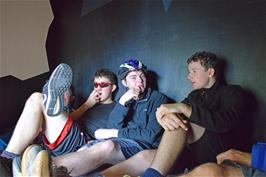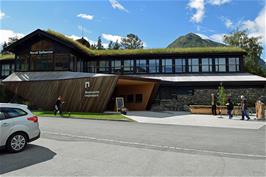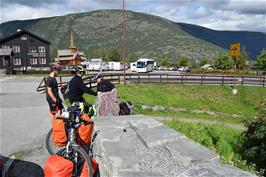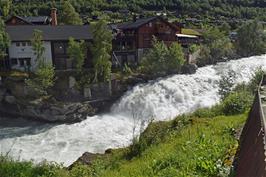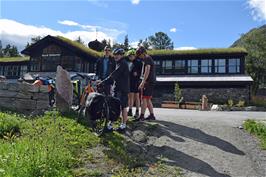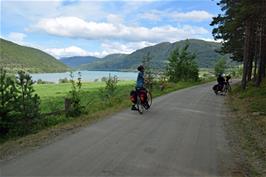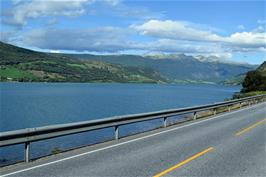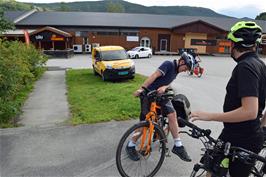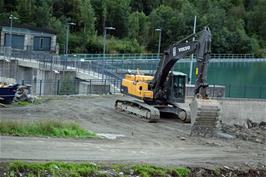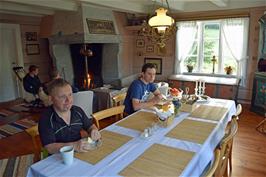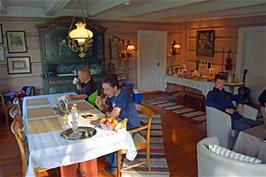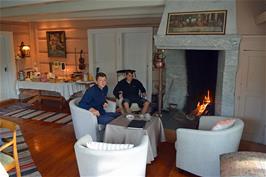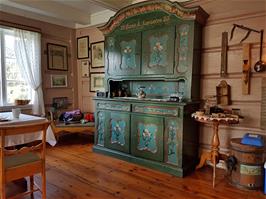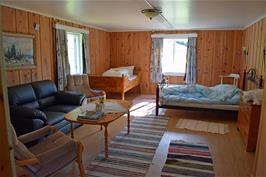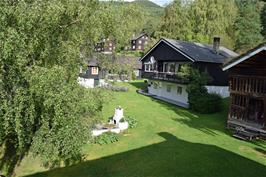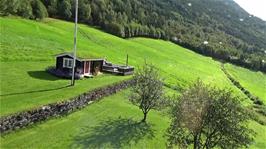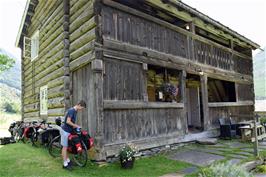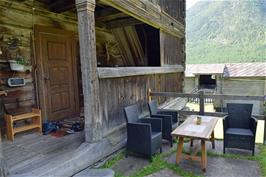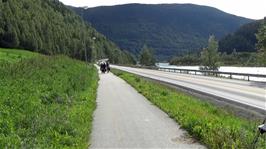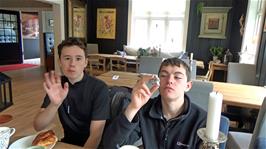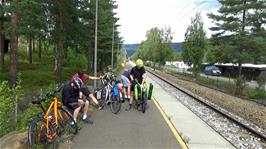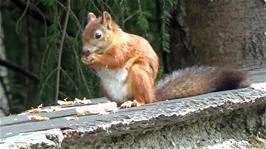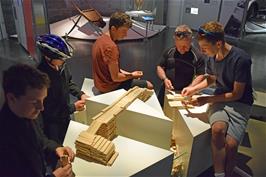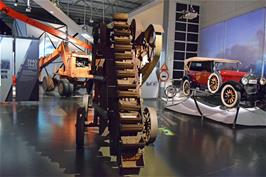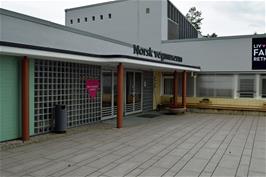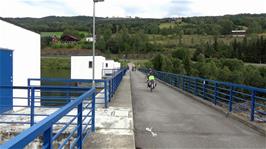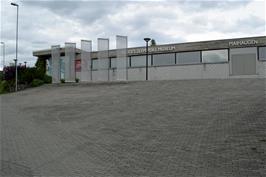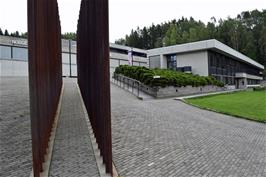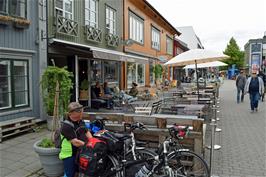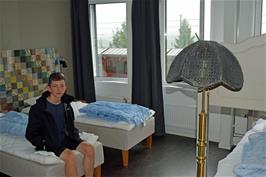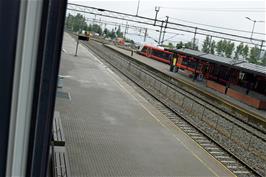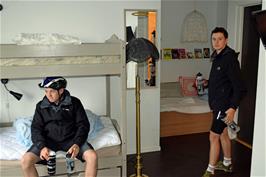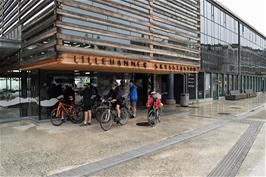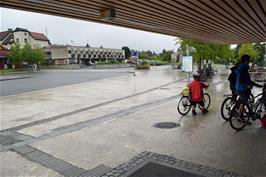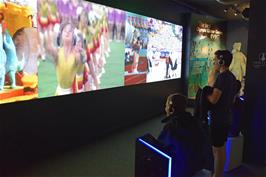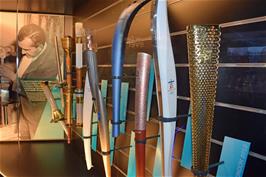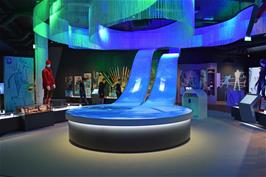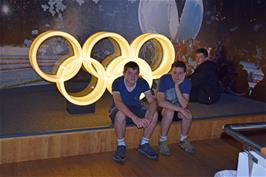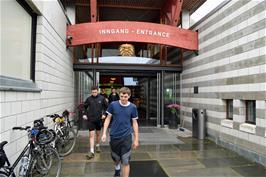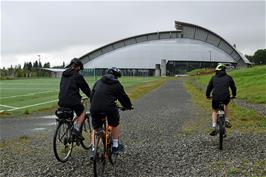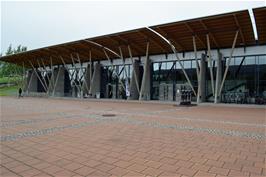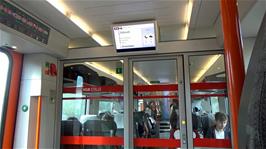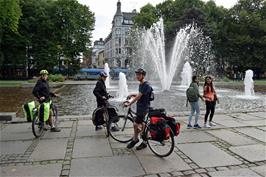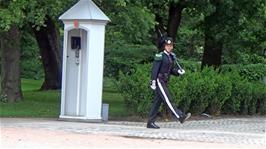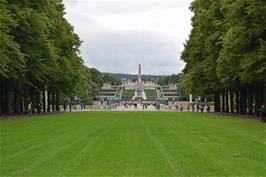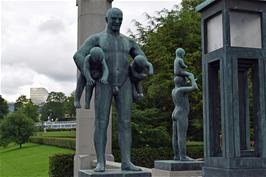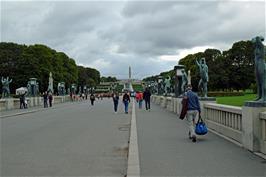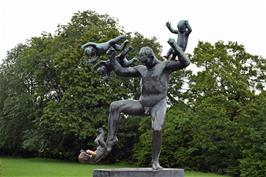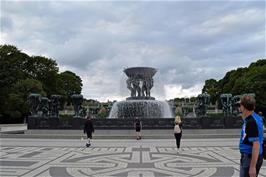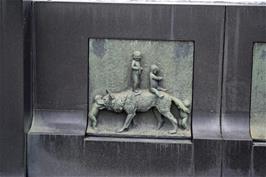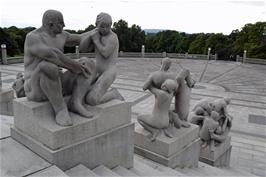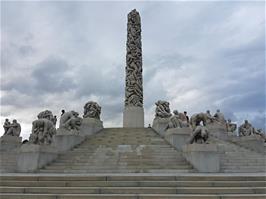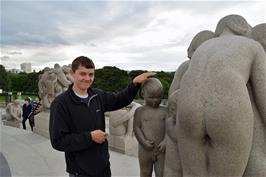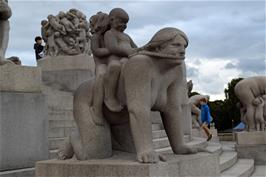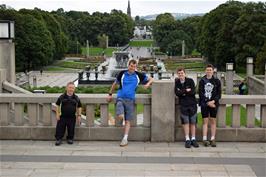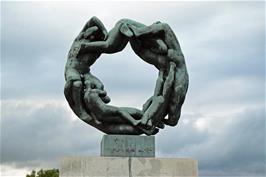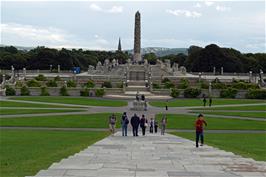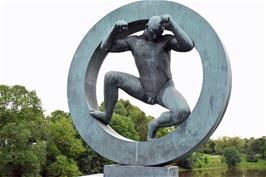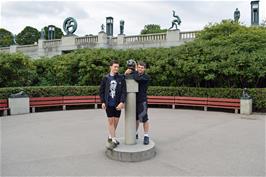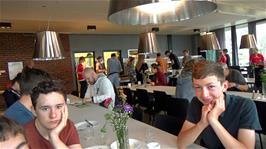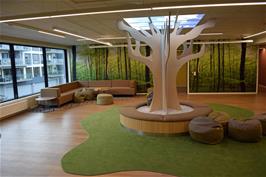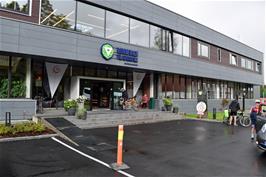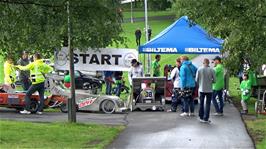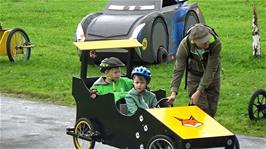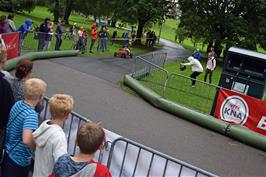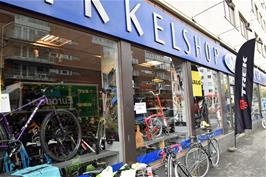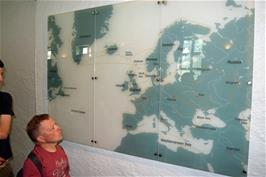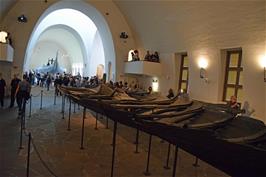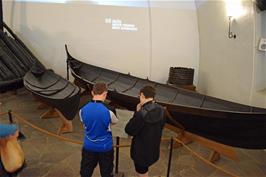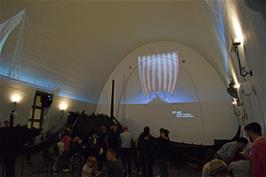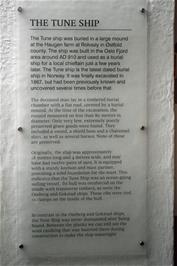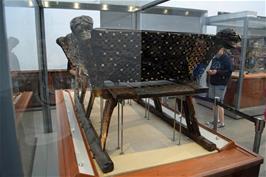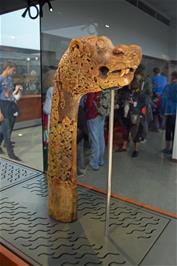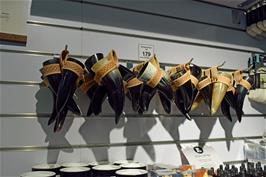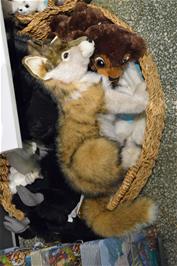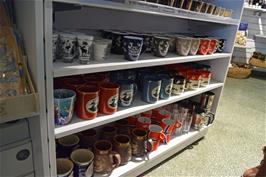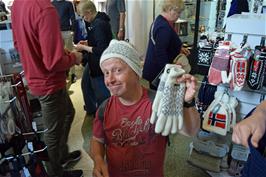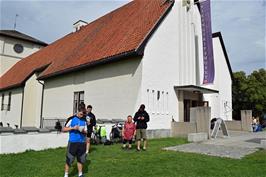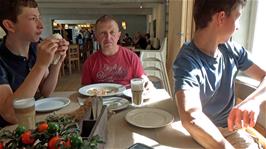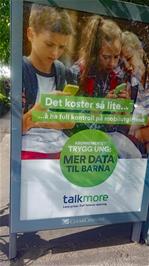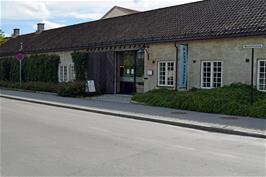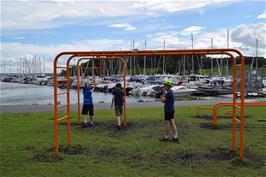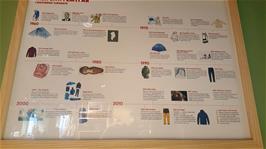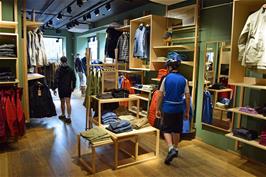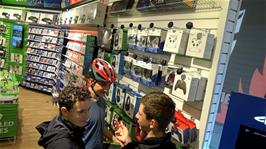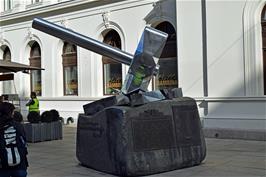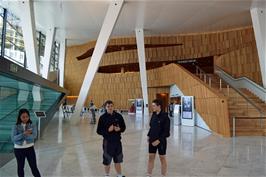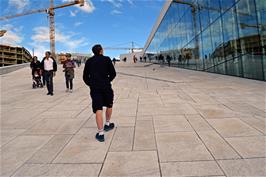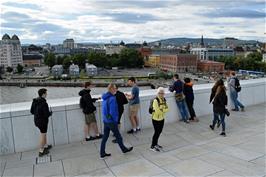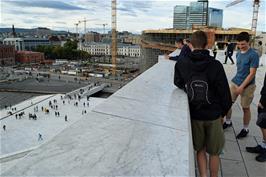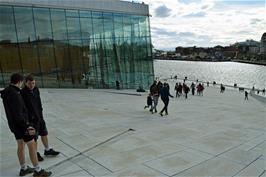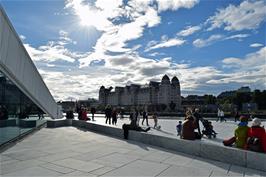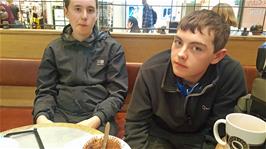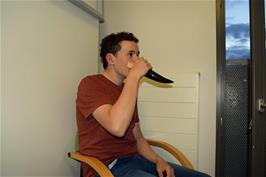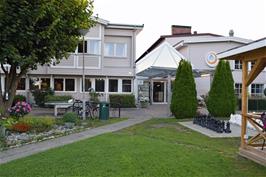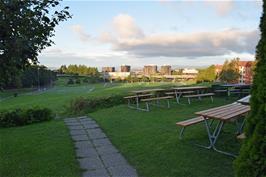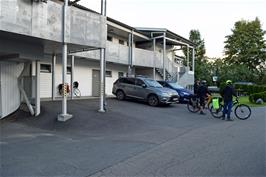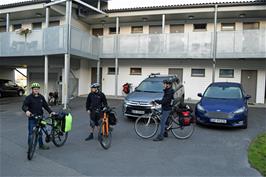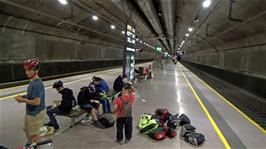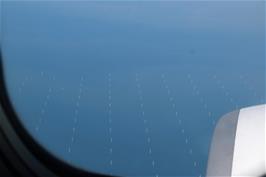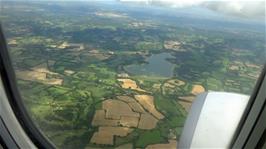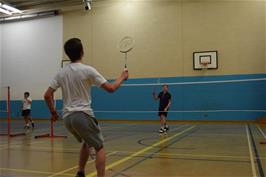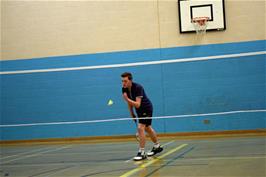South Dartmoor CTC Album
Reports
Saturday 12 August 2017
08:00 - 23:00
08:00 - 23:00
Tour: Norway
Day 5: Mjølfjell to Sogndal YH
Day 5: Mjølfjell to Sogndal YH
Wet morning, sunny spells later
31 miles (▲ 285m ▼ 1195m)
31 miles (▲ 285m ▼ 1195m)
6 Participants:
Dillan Edwards, Michael Jones, Jude Norris, George Rogers, John Rogers, Will Rogers
We awoke to heavy rain, but we had been expecting that. Breakfast was made considerably more difficult by the absence of a toaster and by the fridge having frozen some of our milk solid. Michael suggested a few kitchen improvements to the warden as we prepared to leave: he said he had already bought a toaster but had forgotten to put it in the kitchen for us, and all the other requests would be dealt with soon except for the microwave. Michael asked whether Microwaves were banned at all Norwegian hostels, but the warden said only this one, as he found it hard to disregard the fear of microwaves instilled in him by his mother when he was a child.
We needed to continue the last few miles up the mountain, but apparently the track that went that way was not suitable for cyclists near the top so we were heading 4 miles back down the road to Mjølfjell station. We managed to leave the hostel at 9.32 and rode at a good pace so there would be no chance of missing the only train that would get us to Myrdal in time. Along the way Michael caught John riding on the left hand side of the road – just as well there were no cars around!
There was nobody at the remote station when we arrived but the waiting room was unlocked so we made good use of it until the train arrived at 10.33. There was supposed to be a limit of 5 bikes on these trains but we packed ours in very tightly and nobody complained. The railway line is quite a feat of engineering, passing through many tunnels along the 20-minute journey.
The rain was forecast to stop by late morning, but it was still raining heavily when we got to Myrdal at 10.51 so we settled into the Rallaren café at the station as planned to enjoy pancakes with yoghurt and jam for a very reasonable price along with the now-customary filter coffee. Myrdal is an important station because it is the start of the tourist line down the steep valley to Flåm. The line goes through twenty tunnels, crosses one bridge and is the third most popular tourist attraction in Norway. For cyclists, however, there is a steep track that follows the same route with many hairpin bends – the Rallarvegen. We were deciding over coffee whether to ride the track as planned or take the train. The track had been quite rough when Michael rode it many years ago and John did not particularly fancy a rough track in the rain. The others did not want to miss out on the only serious off-road ride of the tour, however, so John took a few panniers and queued for a ticket while the rest of us crossed the line at the far end of the station and started our downhill adventure.
The first section of the track from the station was every bit as rocky as Michael remembered, but once it joined the main Rallarvegen path things had been markedly improved. The track was indeed twisty with many sharp bends passing some spectacular waterfalls, but the surface was now upgraded to what you might find on any good cycle path. Will couldn’t resist going that little bit too fast near the bottom and managed to come off, but no harm was done and everyone thoroughly enjoyed the descent.
Once the steep sections were completed there was tarmac all the way to Flåm, taking us ever downwards alongside the widening river. We passed a summer cheese farm with scores of goats grazing opposite the entrance, spectacular waterfalls thundering down the sides of the valley and numerous tunnels. We could also see the railway line wending its way down the side of the valley, offering passengers incredible views of this spectacular scenery. Fortunately John was on the train that was heading down so he took some great photos for us of the track we had just descended and the fabulous river valley, although he didn’t see us as we were waiting at the level crossing. It was just as well we didn’t all decide to go by train however, as the train charges tourist rates for the journey – John ended up paying £36 for his ticket and another £18 for the bike!
Arriving at Flåm soon after John’s train we eventually found him among the crowds of people there. The sun was out now so we locked the bikes up near the station and started exploring the cafes and restaurants for a suitable lunch venue. Sadly everything was very expensive and few had any vegetarian food. We tried the Co-op next but that was disappointing too, with mainly tinned and packet food and nothing really exciting for a packed lunch. Eventually John and George bought some hot meaty food from some takeaway stalls in a market area and the rest of us bought hot waffles covered with fruit and jam that were very tasty but came on a flimsy cardboard plate barely larger than the waffle and consequently proved extremely messy to eat.
When Michael was planning the tour we had thought about staying at the youth hostel here, but in the end it didn’t fit with our plans so we were taking a very large, modern, high-speed ferry boat, the Njord, along the Aurlandsfjord to Leikanger on Sognefjord. We boarded the boat at 15:10 with our bikes, having booked our six passenger seats for the hour-long journey in advance for £55. We had been advised to pay for the bikes on board, but we didn’t expect to be charged more for the bikes than for ourselves - £66!
The boat sped along ridiculously fast, giving us great views from the deck at the rear despite the somewhat cloudy and occasionally drizzly conditions. After a while we discovered a small door on the other side of the upper lounge that led to a narrow passenger area at the front of the boat: this provided even better views of the Aurlandsfjord, but the price was non-stop buffeting by gale-force winds produced by the sheer speed of the craft. We were amazed to see a few properties high up on the side of the fjord that seemed to have no visible means of access. The ferry slowed near the Aurlandsfjord waterfall so we could have a good look at it and take some photos.
We arrived at Leikanger Quay spot on time at 16:30, disembarked rapidly and then watched while the boat sped off along the Sognefjord, out of sight within a minute. There seemed to be no cafes or shops in this village so we rode a mile or two to Hermansverk where the large Kiwi store allowed us to stock up with food for tonight and tomorrow (most shops close on Sundays). Michael had also planned a visit to the Fjordkroa café opposite, but it was now 5.15 and we still had a fair way to go so Michael and Dillan went in briefly to share a cup of filter coffee and a cake while John finished his shopping and then we were off.
The ferry crew had told us over the tannoy that the Leikanger area is known for growing fruit. As we rode along the side of the fjord towards Sogndal we passed literally thousands of trees laden with plums and other delicious fruits, some grown right down to the side of the fjord. Our route included cycle detours around two long tunnels that were banned for cyclists but provided peace and tranquillity along the water’s edge.
It was 7pm when we finally arrived at Sogndal. We followed the coastal path into the town and quickly sought out the bus station (Skystassion) where we would need to catch an early bus tomorrow. Next we checked out the supermarkets, calling in to one of them to get some extra provisions, and also checked out the Pizza Bakery that Google Maps recommended as offering good value. It turned out to be exceptional value, with huge, tasty two-person pizzas cooked quickly to order for £14 and nice tables to eat them. Admittedly the choice for vegetarians was limited – of the 28 pizzas on the board, only two were vegetarian - but we all found something we liked and had a good feast there. John treated us all to an interesting drink called Urge, made by the Coca Cola Company of Norway, that was fruity and refreshing.
We were a bit later leaving than we planned because the proprietor didn’t seem to hear John’s order for a third pizza, but once that had been ordered and eaten (by Will and Jude) we set off for the final flat mile to Sogndal hostel, on the outskirts of the town. Expectations were not high when Michael told everyone it was a school for most of the year, but when we arrived it turned out to be very high quality indeed. The “school” was a special kind of college for 19-20 year olds in Norway who want to take a gap year to study a hobby or other interest before continuing to university or college. We walked past beach volleyball courts to get to our sleeping block. The large, luxurious two-bed rooms were arranged in blocks of four with a common lounge, kitchen and laundry. We were very impressed.
Even better news was that the three washing machines and two tumble driers were free to use, so once Michael had paid a visit to the nearby garage to buy a packet of washing powder we sorted all our dirty clothes into piles and started multiple washing cycles to get everything ready for tomorrow. I’m sure this is the first time we have washed our clothes on a tour in such an industrial way, but as the facility was there it made perfect sense. The only downside was that as we were starting quite late, someone had to get up three times in the night to move the washing on to the driers and hang up clothes that needed special treatment. Michael kindly volunteered.
We needed to continue the last few miles up the mountain, but apparently the track that went that way was not suitable for cyclists near the top so we were heading 4 miles back down the road to Mjølfjell station. We managed to leave the hostel at 9.32 and rode at a good pace so there would be no chance of missing the only train that would get us to Myrdal in time. Along the way Michael caught John riding on the left hand side of the road – just as well there were no cars around!
There was nobody at the remote station when we arrived but the waiting room was unlocked so we made good use of it until the train arrived at 10.33. There was supposed to be a limit of 5 bikes on these trains but we packed ours in very tightly and nobody complained. The railway line is quite a feat of engineering, passing through many tunnels along the 20-minute journey.
The rain was forecast to stop by late morning, but it was still raining heavily when we got to Myrdal at 10.51 so we settled into the Rallaren café at the station as planned to enjoy pancakes with yoghurt and jam for a very reasonable price along with the now-customary filter coffee. Myrdal is an important station because it is the start of the tourist line down the steep valley to Flåm. The line goes through twenty tunnels, crosses one bridge and is the third most popular tourist attraction in Norway. For cyclists, however, there is a steep track that follows the same route with many hairpin bends – the Rallarvegen. We were deciding over coffee whether to ride the track as planned or take the train. The track had been quite rough when Michael rode it many years ago and John did not particularly fancy a rough track in the rain. The others did not want to miss out on the only serious off-road ride of the tour, however, so John took a few panniers and queued for a ticket while the rest of us crossed the line at the far end of the station and started our downhill adventure.
The first section of the track from the station was every bit as rocky as Michael remembered, but once it joined the main Rallarvegen path things had been markedly improved. The track was indeed twisty with many sharp bends passing some spectacular waterfalls, but the surface was now upgraded to what you might find on any good cycle path. Will couldn’t resist going that little bit too fast near the bottom and managed to come off, but no harm was done and everyone thoroughly enjoyed the descent.
Once the steep sections were completed there was tarmac all the way to Flåm, taking us ever downwards alongside the widening river. We passed a summer cheese farm with scores of goats grazing opposite the entrance, spectacular waterfalls thundering down the sides of the valley and numerous tunnels. We could also see the railway line wending its way down the side of the valley, offering passengers incredible views of this spectacular scenery. Fortunately John was on the train that was heading down so he took some great photos for us of the track we had just descended and the fabulous river valley, although he didn’t see us as we were waiting at the level crossing. It was just as well we didn’t all decide to go by train however, as the train charges tourist rates for the journey – John ended up paying £36 for his ticket and another £18 for the bike!
Arriving at Flåm soon after John’s train we eventually found him among the crowds of people there. The sun was out now so we locked the bikes up near the station and started exploring the cafes and restaurants for a suitable lunch venue. Sadly everything was very expensive and few had any vegetarian food. We tried the Co-op next but that was disappointing too, with mainly tinned and packet food and nothing really exciting for a packed lunch. Eventually John and George bought some hot meaty food from some takeaway stalls in a market area and the rest of us bought hot waffles covered with fruit and jam that were very tasty but came on a flimsy cardboard plate barely larger than the waffle and consequently proved extremely messy to eat.
When Michael was planning the tour we had thought about staying at the youth hostel here, but in the end it didn’t fit with our plans so we were taking a very large, modern, high-speed ferry boat, the Njord, along the Aurlandsfjord to Leikanger on Sognefjord. We boarded the boat at 15:10 with our bikes, having booked our six passenger seats for the hour-long journey in advance for £55. We had been advised to pay for the bikes on board, but we didn’t expect to be charged more for the bikes than for ourselves - £66!
The boat sped along ridiculously fast, giving us great views from the deck at the rear despite the somewhat cloudy and occasionally drizzly conditions. After a while we discovered a small door on the other side of the upper lounge that led to a narrow passenger area at the front of the boat: this provided even better views of the Aurlandsfjord, but the price was non-stop buffeting by gale-force winds produced by the sheer speed of the craft. We were amazed to see a few properties high up on the side of the fjord that seemed to have no visible means of access. The ferry slowed near the Aurlandsfjord waterfall so we could have a good look at it and take some photos.
We arrived at Leikanger Quay spot on time at 16:30, disembarked rapidly and then watched while the boat sped off along the Sognefjord, out of sight within a minute. There seemed to be no cafes or shops in this village so we rode a mile or two to Hermansverk where the large Kiwi store allowed us to stock up with food for tonight and tomorrow (most shops close on Sundays). Michael had also planned a visit to the Fjordkroa café opposite, but it was now 5.15 and we still had a fair way to go so Michael and Dillan went in briefly to share a cup of filter coffee and a cake while John finished his shopping and then we were off.
The ferry crew had told us over the tannoy that the Leikanger area is known for growing fruit. As we rode along the side of the fjord towards Sogndal we passed literally thousands of trees laden with plums and other delicious fruits, some grown right down to the side of the fjord. Our route included cycle detours around two long tunnels that were banned for cyclists but provided peace and tranquillity along the water’s edge.
It was 7pm when we finally arrived at Sogndal. We followed the coastal path into the town and quickly sought out the bus station (Skystassion) where we would need to catch an early bus tomorrow. Next we checked out the supermarkets, calling in to one of them to get some extra provisions, and also checked out the Pizza Bakery that Google Maps recommended as offering good value. It turned out to be exceptional value, with huge, tasty two-person pizzas cooked quickly to order for £14 and nice tables to eat them. Admittedly the choice for vegetarians was limited – of the 28 pizzas on the board, only two were vegetarian - but we all found something we liked and had a good feast there. John treated us all to an interesting drink called Urge, made by the Coca Cola Company of Norway, that was fruity and refreshing.
We were a bit later leaving than we planned because the proprietor didn’t seem to hear John’s order for a third pizza, but once that had been ordered and eaten (by Will and Jude) we set off for the final flat mile to Sogndal hostel, on the outskirts of the town. Expectations were not high when Michael told everyone it was a school for most of the year, but when we arrived it turned out to be very high quality indeed. The “school” was a special kind of college for 19-20 year olds in Norway who want to take a gap year to study a hobby or other interest before continuing to university or college. We walked past beach volleyball courts to get to our sleeping block. The large, luxurious two-bed rooms were arranged in blocks of four with a common lounge, kitchen and laundry. We were very impressed.
Even better news was that the three washing machines and two tumble driers were free to use, so once Michael had paid a visit to the nearby garage to buy a packet of washing powder we sorted all our dirty clothes into piles and started multiple washing cycles to get everything ready for tomorrow. I’m sure this is the first time we have washed our clothes on a tour in such an industrial way, but as the facility was there it made perfect sense. The only downside was that as we were starting quite late, someone had to get up three times in the night to move the washing on to the driers and hang up clothes that needed special treatment. Michael kindly volunteered.
Sunday 13 August 2017
07:00 - 23:00
07:00 - 23:00
Tour: Norway
Day 6: Glacier walking near Sogndal
Day 6: Glacier walking near Sogndal
Mainly dry with some sunny spells
2 miles (▲ 20m ▼ 20m)
2 miles (▲ 20m ▼ 20m)
6 Participants:
Dillan Edwards, Michael Jones, Jude Norris, George Rogers, John Rogers, Will Rogers
Unusually this year we had decided to take a day off from cycling so that we could engage in one of Norway’s specialist activities - glacier walking. The Jostedal glacier is the largest glacier in continental Europe, covering an area of 487 square kilometres with a length of more than 60 km. One of the branches, called the Nigardsbreen glacier arm, reaches down into a valley just 40 miles from Sogndal and attracts tens of thousands of visitors every year. A special Glacier Bus runs every day from Sogndal to Gaupne and then on up the valley to the Breheimsenteret Glacier Centre.
After an early start and a slightly rushed breakfast we rode our pannier-free bikes back to the bus station, locked them up and caught the 0835 Glacier Bus which was waiting for us. We got some great views of the area that we would be riding tomorrow as the bus took us over the mountain. The announcement system told us about bus stops every few minutes but nobody else got on the bus all the way to Gaupne. Here we changed bus for the second leg of the journey which took us all the way up the Jostedal valley and through Gjerde to the visitor centre. We were now the only people on the bus as it was nearing the end of the summer season, and we were told to enjoy the facilities and exhibition at the centre and come out for the final two-mile bus journey to the glacier area at 11.25.
The visitor centre was very modern and luxurious, offering great views of the Nigardsbreen glacier from the balcony outside the café. We enjoyed good coffee and more pancakes with yoghurt and jam before taking advantage of our tickets for the glacier exhibition, which came free with our pre-purchased tickets for the Blue Ice Hike glacier walk. The exhibition was very interesting and prepared to a high standard. A video presentation started when you stood on the feet spaces marked with your language, explaining how glaciers form and the effect they have on the landscape. A replica of a disease isolation hut highlighted how the whole area was abandoned for 200 years in 1349 because of the Black Death. There was an impressive life size replica of a Stone Age hunter complete with skins and arrows and a replica of a wolverine which Dillan insisted on calling a “bear” for some reason. But then he was calling everything a bear today.
After some group photos on the balcony we took the bus up to the equipment depot where we were given our crampons (spikes that fit around your own shoes) and ice axe and told to dress up warmly, although it was not as cold as it might have been. A short talk from our guide was followed by a walk to the jetty and a boat trip across the Nigardsbreen lake. When Michael came here in 1998 the glacier came right down to the lake, but after 19 years of gradual recession we now had a 40-minute walk to reach the new glacier front. The scale of the glacier was astounding: people waiting to climb it and those already part-way up looked no bigger than ants from where we were.
When we finally reached the foot of the glacier we were shown how to attach our crampons, divided into two groups and then tied together with a rope. Our group now has the Korean guide, and Dillan felt we were missing out when the first group got ten minutes of instructions whilst our guide gave us only thirty seconds. Michael thought it was a complement to our obvious glacier-walking abilities but Dillan was not so sure.
There seemed to be literally hundreds of people walking on the glacier, many of who had started much earlier than us. Narrow steps had been cut into the glacier so that people could climb up, but we had to wait a while before the other groups coming down had cleared the steps. Even when we finally started our climb we had to wait several times for descending groups to pass before we could proceed, which gave us opportunity to take photos and video. An American woman on one of the descending groups couldn’t force herself to negotiate a particularly large step and needed a lot of encouragement and assistance from the guide before she would tackle it.
John, who was understandably a little slower than the rest of the group, found himself moved to the front of the rope after the first section of the climb, so he could set the pace. The required technique was to stamp feet firmly when walking so that the crampons gripped the ice solidly. None of us had even the slightest hint of slipping, although Michael was not too comfortable when we had to jump across a deep chasm in the ice that had no walk board.
By 2.50 we had reached the highest point of our walk, on top of the glacier with spectacular views in all directions. Here we stopped for lunch, photographs and video. John took a great panorama shot with his Galaxy S7 that really captures the incredible location that we had reached. Jude had a bit of a fright when he dropped his new phone and had to watch it slide off down the glacier, but fortunately it stopped before too long and someone was able to retrieve it for him.
The return journey today took us back the way we had come, and once again there were some times when we had to wait for new groups climbing up. From time to time we saw fissures and holes in the glacier where water streams were sometimes running down to an uncertain destination. The guides like to include a walk through caverns in the ice whenever possible, but unfortunately today none of the caverns were safe enough. We could see the “blue ice” effect on some overhanging crevices though. Eventually we returned to the rocks at the base of the glacier after a little more than our booked ninety minutes on the ice. It had been a terrific experience and well worth the £59 charge that we each paid.
John narrowly missed our boat on the way back, perhaps because he stopped for some photos with the guide, so the glacier bus that was waiting to take us back to Sogndal at 5pm was delayed five minutes before we all finally got on board. We were all very tired after our adventure so there wasn’t a lot of talking on the journey back. Perhaps it was because he was so tired that John managed to leave one of his winter gloves on the bus, something that would cause him some problems later in the tour.
Michael, who is well aware of the difficulty of finding good value vegetarian food in Norway, would have been more than happy to return to the Pizza Bakery again for our meal, but everyone else seemed to be tired of pizza and wanted a change. Most of the shops were closed as it was Sunday, but there was a small MENY grocery shop open that provided three of us with Norwegian baked beans and traditional Norwegian brown cheese to cook at the hostel. We left the Rogers family looking for ingredients for one of George’s recipe plans, but later when we were cooking and eating our tasty beans we found out they had been unable to find the flour they wanted and had gone instead to an upmarket burger restaurant.
After an early start and a slightly rushed breakfast we rode our pannier-free bikes back to the bus station, locked them up and caught the 0835 Glacier Bus which was waiting for us. We got some great views of the area that we would be riding tomorrow as the bus took us over the mountain. The announcement system told us about bus stops every few minutes but nobody else got on the bus all the way to Gaupne. Here we changed bus for the second leg of the journey which took us all the way up the Jostedal valley and through Gjerde to the visitor centre. We were now the only people on the bus as it was nearing the end of the summer season, and we were told to enjoy the facilities and exhibition at the centre and come out for the final two-mile bus journey to the glacier area at 11.25.
The visitor centre was very modern and luxurious, offering great views of the Nigardsbreen glacier from the balcony outside the café. We enjoyed good coffee and more pancakes with yoghurt and jam before taking advantage of our tickets for the glacier exhibition, which came free with our pre-purchased tickets for the Blue Ice Hike glacier walk. The exhibition was very interesting and prepared to a high standard. A video presentation started when you stood on the feet spaces marked with your language, explaining how glaciers form and the effect they have on the landscape. A replica of a disease isolation hut highlighted how the whole area was abandoned for 200 years in 1349 because of the Black Death. There was an impressive life size replica of a Stone Age hunter complete with skins and arrows and a replica of a wolverine which Dillan insisted on calling a “bear” for some reason. But then he was calling everything a bear today.
After some group photos on the balcony we took the bus up to the equipment depot where we were given our crampons (spikes that fit around your own shoes) and ice axe and told to dress up warmly, although it was not as cold as it might have been. A short talk from our guide was followed by a walk to the jetty and a boat trip across the Nigardsbreen lake. When Michael came here in 1998 the glacier came right down to the lake, but after 19 years of gradual recession we now had a 40-minute walk to reach the new glacier front. The scale of the glacier was astounding: people waiting to climb it and those already part-way up looked no bigger than ants from where we were.
When we finally reached the foot of the glacier we were shown how to attach our crampons, divided into two groups and then tied together with a rope. Our group now has the Korean guide, and Dillan felt we were missing out when the first group got ten minutes of instructions whilst our guide gave us only thirty seconds. Michael thought it was a complement to our obvious glacier-walking abilities but Dillan was not so sure.
There seemed to be literally hundreds of people walking on the glacier, many of who had started much earlier than us. Narrow steps had been cut into the glacier so that people could climb up, but we had to wait a while before the other groups coming down had cleared the steps. Even when we finally started our climb we had to wait several times for descending groups to pass before we could proceed, which gave us opportunity to take photos and video. An American woman on one of the descending groups couldn’t force herself to negotiate a particularly large step and needed a lot of encouragement and assistance from the guide before she would tackle it.
John, who was understandably a little slower than the rest of the group, found himself moved to the front of the rope after the first section of the climb, so he could set the pace. The required technique was to stamp feet firmly when walking so that the crampons gripped the ice solidly. None of us had even the slightest hint of slipping, although Michael was not too comfortable when we had to jump across a deep chasm in the ice that had no walk board.
By 2.50 we had reached the highest point of our walk, on top of the glacier with spectacular views in all directions. Here we stopped for lunch, photographs and video. John took a great panorama shot with his Galaxy S7 that really captures the incredible location that we had reached. Jude had a bit of a fright when he dropped his new phone and had to watch it slide off down the glacier, but fortunately it stopped before too long and someone was able to retrieve it for him.
The return journey today took us back the way we had come, and once again there were some times when we had to wait for new groups climbing up. From time to time we saw fissures and holes in the glacier where water streams were sometimes running down to an uncertain destination. The guides like to include a walk through caverns in the ice whenever possible, but unfortunately today none of the caverns were safe enough. We could see the “blue ice” effect on some overhanging crevices though. Eventually we returned to the rocks at the base of the glacier after a little more than our booked ninety minutes on the ice. It had been a terrific experience and well worth the £59 charge that we each paid.
John narrowly missed our boat on the way back, perhaps because he stopped for some photos with the guide, so the glacier bus that was waiting to take us back to Sogndal at 5pm was delayed five minutes before we all finally got on board. We were all very tired after our adventure so there wasn’t a lot of talking on the journey back. Perhaps it was because he was so tired that John managed to leave one of his winter gloves on the bus, something that would cause him some problems later in the tour.
Michael, who is well aware of the difficulty of finding good value vegetarian food in Norway, would have been more than happy to return to the Pizza Bakery again for our meal, but everyone else seemed to be tired of pizza and wanted a change. Most of the shops were closed as it was Sunday, but there was a small MENY grocery shop open that provided three of us with Norwegian baked beans and traditional Norwegian brown cheese to cook at the hostel. We left the Rogers family looking for ingredients for one of George’s recipe plans, but later when we were cooking and eating our tasty beans we found out they had been unable to find the flour they wanted and had gone instead to an upmarket burger restaurant.
Monday 14 August 2017
08:00 - 23:00
08:00 - 23:00
Tour: Norway
Day 7: Sogndal to Skjolden YH
Day 7: Sogndal to Skjolden YH
Increasingly sunny & warm with occasional showers
36 miles (▲ 525m ▼ 585m)
36 miles (▲ 525m ▼ 585m)
6 Participants:
Dillan Edwards, Michael Jones, Jude Norris, George Rogers, John Rogers, Will Rogers
Our second breakfast at Sogndal youth hostel was excellent, with tasty bread, a toaster, good filter coffee and perfectly white boiled eggs that were slightly runny inside – hard to achieve according to Dillan. As we were checking out, a German cyclist seemed impressed with Michael’s toolkit, especially with the fact that he had a chain link remover: he had one too, but hadn’t had enough time yesterday to assist another passing cyclist who needed one.
We left the hostel at around 10.15 and headed initially back into town to visit the enormous REMA 1000 supermarket to buy lunch. As the young checkout assistant didn’t seem too busy Michael asked him why Volvo were not the number one brand in Norway since they are Scandinavian. He said the Volvo brand is very well liked but taxes make them nearly twice as expensive as the equivalent £30k Toyota and VW models so only the well-off can afford one.
Michael had only identified two cafes along our route today, so we decided to ride all the way to the first one, at Marifjøra, before stopping. There was only one route to take, and that led us alongside the Barsnes fjord, with great views of the mountains reflected in the water, and then up the same mountain climb to Hafslo we had taken yesterday on the bus. It wasn’t a steep climb, but we needed to take shelter from a shower when we reached a bus stop near the top so we used the opportunity to try some more Norwegian chocolate from our panniers. Once the rain stopped we were rewarded with a very enjoyable five mile downhill.
The Marifjøra café turned out to be a “chocolate café”: customers could watch luxury chocolates being hand-made in an adjacent room whilst enjoying their coffee and cake. Unfortunately the coffees were very small, there were only about two types of cake available and the tiny chocolates were £2 each! There were no other customers and only one member of staff on duty, and she shared her time between the counter and the chocolate-making. George thought he had found a better deal with a whole box of the chocolates for only £2.20, but when John came to pay he discovered the price was actually £22 so he politely asked for a refund. It was a nice café however and we enjoyed our quiet stay there, so in the end we all bought a chocolate each: very nice, but not worth £2.
Outside the café was a large open area next to the beautiful Lustra fjord, so we settled down on the seats to enjoy our packed lunch. A seal popped up in the fjord during a nasty little shower and Dillan managed to catch a glimpse of it on the video camera. Soon the sun came out and we spent an enjoyable half hour there enjoying the fabulous scenery and trying our balancing skills on a slightly unstable wooden pole. As we were preparing to leave, John offered Michael a piece of tasty Norwegian chocolate for which Michael thanked him; only then did John reveal it was Michael’s own chocolate that he had “found” near the seats.
Another two miles along the edge of the fjord brought us to Gaupne where we visited the Coop Prix supermarket to stock up with food for tonight and tomorrow. Having searched the whole store for vegetarian options and finding only a single small shelf containing just three uninspiring packet meals most of us decided to keep things simple and buy eggs and cheese to make omelettes. Outside in the sunshine Jude made the most of the excellent mobile data signal by making his first video call to his Mum back in England.
Gaupne is located at the end of a side-branch of the Lustrafjord and our route took us back along the waterside to the main fjord. The views across the fjord arm back to Marifjøra were fabulous in the afternoon sunshine but when we hit the main fjord the scenery was simply breath-taking. We stayed there for nearly half an hour taking photos and sending pictures back to England. When it came to taking a group photo Michael had cleverly forgotten how to set up a timer on the shutter release. He managed to get something working in the end but in his haste got the settings wrong, which made for an interesting over-exposed photograph.
Leaving there at 4.15 we had to make good speed to cover the six miles to our next stop, the Lustrabui Bakery, before it closed at 5pm. Michael didn’t help things by leaving his helmet at the viewpoint, but fortunately Will had seen it and picked it up and then the whole route was pretty much flat. We arrived at 4.48 and were delighted to find a warm welcome, a huge range of freshly-baked pastries and cakes at very reasonable prices, a real coffee machine and cosy tables. This turned out to be one of the best cafes of the tour and some of us stocked up with more pastries for later as we left at 5.06.
Everyone in the group imagined that this would be a great place to live, with huge fjords, unspoiled mountains, luxury houses near the water and a great local bakery and café. In all our time so far in Norway we had never really seen any run-down poorer areas, so clearly most people have a generally good standard of living.
There were two more tunnels to negotiate before we reached Skjolden, the first of which had a cycle path around it, partially blocked by a fallen tree, and the second requiring us to go through as the path had long-since crumbled into the fjord. The youngsters got excited when they saw a diving board near the fjord at Skjolden until they realised it had been moved away from the water’s edge and so could not be used. Michael took everyone to a bridge over the fast-flowing river where we could see the building that was Skjolden youth hostel on our last visit in 1995, now run as a Christian retreat.
A few more flat miles brought us to the new hostel, located impressively in a magnificent valley between steep-sided mountains with lofty waterfalls. The proprietor runs the site as both a camp site and a hostel but we didn’t realise the full implications of this as we checked in at the plush reception office in the restaurant block. She asked to see our YHA cards (the only hostel on the tour that did so) before giving us our 10% member discount and then sent us to our rooms, which were in the youth hostel block on the other side of the back garden. Our rooms were at the near end on the first floor but we had to walk right down to the far end before we could find the stairs. The rooms were OK but the 4-bed room was a little too cramped for George’s liking.
The food in the restaurant looked very nice but there was nothing vegetarian on the menu and the prices were £20 per person, so we proceeded as planned to cook our own food in the spacious self-catering kitchen and common room in the youth hostel block. The omelettes turned out very well once we had found the right utensils, and the TV would have been excellent if only it had offered more than two non-English channels – selecting most channels resulted in a message requesting a viewing card to be inserted.
Now, however, we ran into a bit of a problem. The hostel advertises “Free wi-fi” (like nearly all Norwegian hostels) and an “Internet café”, but the free wi-fi did not extend as far as the youth hostel block and the mobile internet signal there was very poor. This was a problem because the next episode of Game of Thrones was available today and everyone wanted to see it. We walked outside the block towards the reception / restaurant building and found that the wi-fi became available only when we reached the tables in the garden immediately outside the restaurant. Michael had asked earlier if we could sit in the restaurant after our meal to use the wi-fi and she had said we could do that as soon as the diners had left. Now, however, she was saying that this was an Internet Café and that we would need to buy a drink (well over £4) if we wanted to sit in there.
We didn’t think we should have to spend any money in order to get the free wi-fi we had been promised, so when Michael had finally set up NowTV on his phone we put some tables and chairs together outside the restaurant and tried watching the programme in the garden. The waterfalls were nice but produced a lot of background noise, there were a few midges around and it was a little chilly so it didn’t take us long to decide that we would be better off buying the drink and getting inside. Now, however, the rules had changed again: we would all have to buy drinks if we all wanted to sit inside, even though there was nobody else in the restaurant! Michael really couldn’t believe what he was hearing. Just to make quite certain he was understanding her correctly he offered her the choice of us buying a single drink to sit inside or buying nothing and watching the programme outside. She looked slightly irritated and said we were welcome to sit outside then! She said she was sure we would understand why she had to do that. We didn’t.
So we sat outside in the dark, huddled around a Galaxy S7 Edge, and somehow managed to enjoy Game of Thrones despite our host’s best efforts to ruin it for us. If it had been raining the promised “free wi-fi” would not have been available to us at all, so clearly they need to either extend the free wi-fi to the hostel block or allow hostel members to use the “internet café” without charge. This problem highlights a conflict of interest for the proprietor who is trying to maximise her profits while trying to run two different kinds of establishments together, so we emailed some helpful comments to the Norwegian hostel association on our return to England that should hopefully remedy this situation for future hostellers.
We left the hostel at around 10.15 and headed initially back into town to visit the enormous REMA 1000 supermarket to buy lunch. As the young checkout assistant didn’t seem too busy Michael asked him why Volvo were not the number one brand in Norway since they are Scandinavian. He said the Volvo brand is very well liked but taxes make them nearly twice as expensive as the equivalent £30k Toyota and VW models so only the well-off can afford one.
Michael had only identified two cafes along our route today, so we decided to ride all the way to the first one, at Marifjøra, before stopping. There was only one route to take, and that led us alongside the Barsnes fjord, with great views of the mountains reflected in the water, and then up the same mountain climb to Hafslo we had taken yesterday on the bus. It wasn’t a steep climb, but we needed to take shelter from a shower when we reached a bus stop near the top so we used the opportunity to try some more Norwegian chocolate from our panniers. Once the rain stopped we were rewarded with a very enjoyable five mile downhill.
The Marifjøra café turned out to be a “chocolate café”: customers could watch luxury chocolates being hand-made in an adjacent room whilst enjoying their coffee and cake. Unfortunately the coffees were very small, there were only about two types of cake available and the tiny chocolates were £2 each! There were no other customers and only one member of staff on duty, and she shared her time between the counter and the chocolate-making. George thought he had found a better deal with a whole box of the chocolates for only £2.20, but when John came to pay he discovered the price was actually £22 so he politely asked for a refund. It was a nice café however and we enjoyed our quiet stay there, so in the end we all bought a chocolate each: very nice, but not worth £2.
Outside the café was a large open area next to the beautiful Lustra fjord, so we settled down on the seats to enjoy our packed lunch. A seal popped up in the fjord during a nasty little shower and Dillan managed to catch a glimpse of it on the video camera. Soon the sun came out and we spent an enjoyable half hour there enjoying the fabulous scenery and trying our balancing skills on a slightly unstable wooden pole. As we were preparing to leave, John offered Michael a piece of tasty Norwegian chocolate for which Michael thanked him; only then did John reveal it was Michael’s own chocolate that he had “found” near the seats.
Another two miles along the edge of the fjord brought us to Gaupne where we visited the Coop Prix supermarket to stock up with food for tonight and tomorrow. Having searched the whole store for vegetarian options and finding only a single small shelf containing just three uninspiring packet meals most of us decided to keep things simple and buy eggs and cheese to make omelettes. Outside in the sunshine Jude made the most of the excellent mobile data signal by making his first video call to his Mum back in England.
Gaupne is located at the end of a side-branch of the Lustrafjord and our route took us back along the waterside to the main fjord. The views across the fjord arm back to Marifjøra were fabulous in the afternoon sunshine but when we hit the main fjord the scenery was simply breath-taking. We stayed there for nearly half an hour taking photos and sending pictures back to England. When it came to taking a group photo Michael had cleverly forgotten how to set up a timer on the shutter release. He managed to get something working in the end but in his haste got the settings wrong, which made for an interesting over-exposed photograph.
Leaving there at 4.15 we had to make good speed to cover the six miles to our next stop, the Lustrabui Bakery, before it closed at 5pm. Michael didn’t help things by leaving his helmet at the viewpoint, but fortunately Will had seen it and picked it up and then the whole route was pretty much flat. We arrived at 4.48 and were delighted to find a warm welcome, a huge range of freshly-baked pastries and cakes at very reasonable prices, a real coffee machine and cosy tables. This turned out to be one of the best cafes of the tour and some of us stocked up with more pastries for later as we left at 5.06.
Everyone in the group imagined that this would be a great place to live, with huge fjords, unspoiled mountains, luxury houses near the water and a great local bakery and café. In all our time so far in Norway we had never really seen any run-down poorer areas, so clearly most people have a generally good standard of living.
There were two more tunnels to negotiate before we reached Skjolden, the first of which had a cycle path around it, partially blocked by a fallen tree, and the second requiring us to go through as the path had long-since crumbled into the fjord. The youngsters got excited when they saw a diving board near the fjord at Skjolden until they realised it had been moved away from the water’s edge and so could not be used. Michael took everyone to a bridge over the fast-flowing river where we could see the building that was Skjolden youth hostel on our last visit in 1995, now run as a Christian retreat.
A few more flat miles brought us to the new hostel, located impressively in a magnificent valley between steep-sided mountains with lofty waterfalls. The proprietor runs the site as both a camp site and a hostel but we didn’t realise the full implications of this as we checked in at the plush reception office in the restaurant block. She asked to see our YHA cards (the only hostel on the tour that did so) before giving us our 10% member discount and then sent us to our rooms, which were in the youth hostel block on the other side of the back garden. Our rooms were at the near end on the first floor but we had to walk right down to the far end before we could find the stairs. The rooms were OK but the 4-bed room was a little too cramped for George’s liking.
The food in the restaurant looked very nice but there was nothing vegetarian on the menu and the prices were £20 per person, so we proceeded as planned to cook our own food in the spacious self-catering kitchen and common room in the youth hostel block. The omelettes turned out very well once we had found the right utensils, and the TV would have been excellent if only it had offered more than two non-English channels – selecting most channels resulted in a message requesting a viewing card to be inserted.
Now, however, we ran into a bit of a problem. The hostel advertises “Free wi-fi” (like nearly all Norwegian hostels) and an “Internet café”, but the free wi-fi did not extend as far as the youth hostel block and the mobile internet signal there was very poor. This was a problem because the next episode of Game of Thrones was available today and everyone wanted to see it. We walked outside the block towards the reception / restaurant building and found that the wi-fi became available only when we reached the tables in the garden immediately outside the restaurant. Michael had asked earlier if we could sit in the restaurant after our meal to use the wi-fi and she had said we could do that as soon as the diners had left. Now, however, she was saying that this was an Internet Café and that we would need to buy a drink (well over £4) if we wanted to sit in there.
We didn’t think we should have to spend any money in order to get the free wi-fi we had been promised, so when Michael had finally set up NowTV on his phone we put some tables and chairs together outside the restaurant and tried watching the programme in the garden. The waterfalls were nice but produced a lot of background noise, there were a few midges around and it was a little chilly so it didn’t take us long to decide that we would be better off buying the drink and getting inside. Now, however, the rules had changed again: we would all have to buy drinks if we all wanted to sit inside, even though there was nobody else in the restaurant! Michael really couldn’t believe what he was hearing. Just to make quite certain he was understanding her correctly he offered her the choice of us buying a single drink to sit inside or buying nothing and watching the programme outside. She looked slightly irritated and said we were welcome to sit outside then! She said she was sure we would understand why she had to do that. We didn’t.
So we sat outside in the dark, huddled around a Galaxy S7 Edge, and somehow managed to enjoy Game of Thrones despite our host’s best efforts to ruin it for us. If it had been raining the promised “free wi-fi” would not have been available to us at all, so clearly they need to either extend the free wi-fi to the hostel block or allow hostel members to use the “internet café” without charge. This problem highlights a conflict of interest for the proprietor who is trying to maximise her profits while trying to run two different kinds of establishments together, so we emailed some helpful comments to the Norwegian hostel association on our return to England that should hopefully remedy this situation for future hostellers.
Tuesday 15 August 2017
08:00 - 23:00
08:00 - 23:00
Tour: Norway
Day 8: Skjolden to Sognefjellshytta
Day 8: Skjolden to Sognefjellshytta
Cloudy with sunny spells, turning wet and cold
19 miles (▲ 1465m ▼ 55m)
19 miles (▲ 1465m ▼ 55m)
6 Participants:
Dillan Edwards, Michael Jones, Jude Norris, George Rogers, John Rogers, Will Rogers
Breakfast was included with our overnight so finally we were allowed into the restaurant area to claim our not-so-free wi-fi. The lack of yoghurts was a disappointment but we nevertheless ate well. The German cyclist from Sogndal was also staying at the hostel and he was impressed to hear that we were “going over the top” today. He had been unable to obtain reassurance about the steepest gradient on the climb so he and his partner would be aiming to do it next year.
We really needed to leave early today but it was 10.15 when we started riding the 1.6 miles up the road to the supermarket at Fortun. We passed the MECA car repair garage along the way, so Michael checked out their fresh food offerings before continuing to the small supermarket in the village. This was the last shop for thirty four miles so we stocked up with snacks and Nigard chocolate (on special offer of £2 per bar). Sadly there was nothing here ideal for packed lunches so we sent John on up the mountain while the rest of us returned to the garage.
Here the mother and son team set about making up 5 baguettes with custom vegetarian fillings (cheese and salad). The process took half an hour which gave us time to buy coffees from the machine and chat about everyday life in Fortun. The mountain road is closed by snowfall in November and remains closed until 1 May the following year. The journey to Lom, which normally takes around an hour and a half by car, increases to four and a half hours when the road is closed so most people don’t bother. Only around 20 people live in the village over the long winter period but the garage is kept in business by the many tourists that visit during the short summer season. The temperature on top of the mountain would be around two degrees and she thought we would get too cold if we wore only shorts. A Swedish motorcyclist refuelling at the garage told Michael he owns a Volvo and that the brand is even more popular in Sweden as taxes there are not so prohibitive.
Now, finally, at around 11.20, we set off for the big climb over the highest mountain pass road in Northern Europe, the Sognefjellsvegen. From a height of 26m at the Fortun garage it climbs to 1434m at the highest point, Fantesteinen, over a distance of 17 miles (28km) and then descends similarly on the far side to Bøverdalen youth hostel. The forecast seemed better than we had expected for most of the day but there was rain in the air for later so we wanted to keep up a good pace.
Things started to go wrong when George’s chain jammed on the first hill out of Fortun. Michael fixed that, but then we found John after the second hairpin bend: he should have been miles up the hill by now, but he had got a puncture on some broken glass and had been working hard to repair it. We set off again after another ten minutes, but now Will had got it into his head that somehow we would reach the top quicker if he and George went on ahead. Michael tried to explain that it would be very cold at the top and we would make the fastest progress if we stuck together, but they went on anyway and then slowed us down by ringing John several times to ask about lunches, turnings and other matters!
It was a long, slow climb with fabulous mountain views, but thankfully it was not too steep. A small flock of sheep tried desperately to break down their fence to reach us at one point – they had plenty of grass to eat, so we weren’t quite sure why they were so interested in us. Michael remembered happy times as we passed a Jacuzzi-style pool and waterfall on the approach to Turtagrø – we stopped there on a sweltering July day in 1995 to cool our shirts in the icy glacier water. We stopped by the road for a quick bite of lunch, chatting with a couple from Wimbledon who were staying in the Turtagrø Hotel on a walking holiday. They had heard that weather conditions on the other side of the mountain had turned very nasty so they were returning to the hotel for afternoon tea. Michael and Dillan decided to join them for two quick coffees at £3.50 each while John pressed on up the hill and Jude waited patiently outside.
It was while we were sitting in the coffee lounge admiring the views that George rang to say it had turned cold and wet so they had decided to wait for us at the 1100m point. Well that was a very sensible decision. We chased John up the multiple hairpin bends, stopping for photos at each 100m height sign and at each of the spectacular viewpoints. By the time we got to 1100m conditions were distinctly damp and cold and both Will and George, who had been waiting 45 minutes, were pleased to see us. Michael said he would forgive them both … as long as they bent the knee.
The road became less steep as we went on but there were still 9 miles to cover before we reached Fantesteinen and conditions were deteriorating. At 1323m we found a large patch of snow near the Galgebergstjørnane Lake and somehow found the energy and enthusiasm to stop for an August snowball fight. By the time we crossed the causeway over the Øvre Hervavatnet Lake at 1392m the rain felt like bullets as it was driven against our faces by the strong winds. The rain got heavier, everyone had cold, wet feet and shoes, it was 5.12pm and there were still 4.7 miles to the top and a further 17 miles down the other side in the rain. The situation looked grim.
It was time to revert to the contingency plans. Michael knew there was a hotel near the top of the mountain – the Sognefjellshytta - so he needed to get everyone in there to warm up and dry off as quickly as possible. What he didn’t know, however, is that it had been modernised and extended since he last passed it many years ago. There is now a huge heated wood and glass atrium over the entrance area with a gravel floor – ideal for dripping hikers and cyclists to dry off. The relief we felt as we got inside and lay down was indescribable. John and Will, who were five minutes behind us, didn’t know the hotel even existed so their appreciation of this haven in the wilderness was even greater. We spent a long time just soaking up the warmth, drying off and feeling extreme gratitude towards whoever it was that built a hotel here.
Hot coffees from the reception desk for £2.50 each aided the next stage of our revival, then the hotel manager came over to review our situation and discuss options with Michael. He saw that the youngsters were cold and wet so he immediately offered free hot showers to everyone. The rain was now heavier than ever and was apparently even worse down the other side so Michael asked about options for transporting us down to Bøverdalen youth hostel. It then became apparent, however, that he had a warm, cosy restaurant there at the hotel along with multiple rooms that were of a similar standard to the hostel rooms. He wanted us to stay as he thought it would be best for us, and he offered various incentives to encourage us. First, he would reduce the bed price from £66 to £45 per person, and he would offer us a full three-course chef-prepared meal in the restaurant for £25 instead of the usual £35. We were already on the point of agreeing as nobody wanted to go out in the rain again, but to clinch the deal he offered to refund our coffee charges and to ring the hostel for us to ensure we wouldn’t have to pay anything to them. It would mean we would have a longer day tomorrow but the forecast was dry and sunny in the morning so we would actually be able to enjoy the downhill.
We luxuriated in the piping hot showers for far longer than usual, then settled down in the restaurant to enjoy the special vegetarian Quorn meals that Chef had prepared for us. Looking out of the little windows at the surrounding snow and rain we just couldn’t believe our good fortune. Never have we appreciated a place as much as we appreciated the Songefjellshytta this evening. If there is a heaven somewhere it must feel a lot like this felt to us.
We soon retired to our beds with the rain beating down on the windows all night, feeling so grateful to be warm and well fed. There was a cost involved in all this, but under the circumstances we felt it was money very well spent.
We really needed to leave early today but it was 10.15 when we started riding the 1.6 miles up the road to the supermarket at Fortun. We passed the MECA car repair garage along the way, so Michael checked out their fresh food offerings before continuing to the small supermarket in the village. This was the last shop for thirty four miles so we stocked up with snacks and Nigard chocolate (on special offer of £2 per bar). Sadly there was nothing here ideal for packed lunches so we sent John on up the mountain while the rest of us returned to the garage.
Here the mother and son team set about making up 5 baguettes with custom vegetarian fillings (cheese and salad). The process took half an hour which gave us time to buy coffees from the machine and chat about everyday life in Fortun. The mountain road is closed by snowfall in November and remains closed until 1 May the following year. The journey to Lom, which normally takes around an hour and a half by car, increases to four and a half hours when the road is closed so most people don’t bother. Only around 20 people live in the village over the long winter period but the garage is kept in business by the many tourists that visit during the short summer season. The temperature on top of the mountain would be around two degrees and she thought we would get too cold if we wore only shorts. A Swedish motorcyclist refuelling at the garage told Michael he owns a Volvo and that the brand is even more popular in Sweden as taxes there are not so prohibitive.
Now, finally, at around 11.20, we set off for the big climb over the highest mountain pass road in Northern Europe, the Sognefjellsvegen. From a height of 26m at the Fortun garage it climbs to 1434m at the highest point, Fantesteinen, over a distance of 17 miles (28km) and then descends similarly on the far side to Bøverdalen youth hostel. The forecast seemed better than we had expected for most of the day but there was rain in the air for later so we wanted to keep up a good pace.
Things started to go wrong when George’s chain jammed on the first hill out of Fortun. Michael fixed that, but then we found John after the second hairpin bend: he should have been miles up the hill by now, but he had got a puncture on some broken glass and had been working hard to repair it. We set off again after another ten minutes, but now Will had got it into his head that somehow we would reach the top quicker if he and George went on ahead. Michael tried to explain that it would be very cold at the top and we would make the fastest progress if we stuck together, but they went on anyway and then slowed us down by ringing John several times to ask about lunches, turnings and other matters!
It was a long, slow climb with fabulous mountain views, but thankfully it was not too steep. A small flock of sheep tried desperately to break down their fence to reach us at one point – they had plenty of grass to eat, so we weren’t quite sure why they were so interested in us. Michael remembered happy times as we passed a Jacuzzi-style pool and waterfall on the approach to Turtagrø – we stopped there on a sweltering July day in 1995 to cool our shirts in the icy glacier water. We stopped by the road for a quick bite of lunch, chatting with a couple from Wimbledon who were staying in the Turtagrø Hotel on a walking holiday. They had heard that weather conditions on the other side of the mountain had turned very nasty so they were returning to the hotel for afternoon tea. Michael and Dillan decided to join them for two quick coffees at £3.50 each while John pressed on up the hill and Jude waited patiently outside.
It was while we were sitting in the coffee lounge admiring the views that George rang to say it had turned cold and wet so they had decided to wait for us at the 1100m point. Well that was a very sensible decision. We chased John up the multiple hairpin bends, stopping for photos at each 100m height sign and at each of the spectacular viewpoints. By the time we got to 1100m conditions were distinctly damp and cold and both Will and George, who had been waiting 45 minutes, were pleased to see us. Michael said he would forgive them both … as long as they bent the knee.
The road became less steep as we went on but there were still 9 miles to cover before we reached Fantesteinen and conditions were deteriorating. At 1323m we found a large patch of snow near the Galgebergstjørnane Lake and somehow found the energy and enthusiasm to stop for an August snowball fight. By the time we crossed the causeway over the Øvre Hervavatnet Lake at 1392m the rain felt like bullets as it was driven against our faces by the strong winds. The rain got heavier, everyone had cold, wet feet and shoes, it was 5.12pm and there were still 4.7 miles to the top and a further 17 miles down the other side in the rain. The situation looked grim.
It was time to revert to the contingency plans. Michael knew there was a hotel near the top of the mountain – the Sognefjellshytta - so he needed to get everyone in there to warm up and dry off as quickly as possible. What he didn’t know, however, is that it had been modernised and extended since he last passed it many years ago. There is now a huge heated wood and glass atrium over the entrance area with a gravel floor – ideal for dripping hikers and cyclists to dry off. The relief we felt as we got inside and lay down was indescribable. John and Will, who were five minutes behind us, didn’t know the hotel even existed so their appreciation of this haven in the wilderness was even greater. We spent a long time just soaking up the warmth, drying off and feeling extreme gratitude towards whoever it was that built a hotel here.
Hot coffees from the reception desk for £2.50 each aided the next stage of our revival, then the hotel manager came over to review our situation and discuss options with Michael. He saw that the youngsters were cold and wet so he immediately offered free hot showers to everyone. The rain was now heavier than ever and was apparently even worse down the other side so Michael asked about options for transporting us down to Bøverdalen youth hostel. It then became apparent, however, that he had a warm, cosy restaurant there at the hotel along with multiple rooms that were of a similar standard to the hostel rooms. He wanted us to stay as he thought it would be best for us, and he offered various incentives to encourage us. First, he would reduce the bed price from £66 to £45 per person, and he would offer us a full three-course chef-prepared meal in the restaurant for £25 instead of the usual £35. We were already on the point of agreeing as nobody wanted to go out in the rain again, but to clinch the deal he offered to refund our coffee charges and to ring the hostel for us to ensure we wouldn’t have to pay anything to them. It would mean we would have a longer day tomorrow but the forecast was dry and sunny in the morning so we would actually be able to enjoy the downhill.
We luxuriated in the piping hot showers for far longer than usual, then settled down in the restaurant to enjoy the special vegetarian Quorn meals that Chef had prepared for us. Looking out of the little windows at the surrounding snow and rain we just couldn’t believe our good fortune. Never have we appreciated a place as much as we appreciated the Songefjellshytta this evening. If there is a heaven somewhere it must feel a lot like this felt to us.
We soon retired to our beds with the rain beating down on the windows all night, feeling so grateful to be warm and well fed. There was a cost involved in all this, but under the circumstances we felt it was money very well spent.
Wednesday 16 August 2017
08:00 - 23:00
08:00 - 23:00
Tour: Norway
Day 9: Sognefjellshytta to Otta B&B
Day 9: Sognefjellshytta to Otta B&B
Increasingly sunny
67 miles (▲ 380m ▼ 1465m)
67 miles (▲ 380m ▼ 1465m)
6 Participants:
Dillan Edwards, Michael Jones, Jude Norris, George Rogers, John Rogers, Will Rogers
The drying room had been cold when we went to bed last nigh and despite the owner’s assurances that he would get it working before he went to bed Michael found it still cold when he checked at 2am. He moved some of the wet shoes to our room with some newspaper inserted, but annoyingly they would have been better left in the drying room as it was hot when we woke up at 7.45.
It was a cold morning and there was still some light rain around as we went down for our 8.10 breakfast, which today was a little more interesting than usual. Here they had a waffle-making machine where you had to spread the batter on the mould, close the lid and wait for the green light to show. Dillan used too much batter on his first attempt which caused a bit of a mess, but we soon got it right and enjoyed tasty hot waffles smothered in yoghurt, jam and honey.
The result of last night’s change to the itinerary was that we now had 67 miles to cover today instead of the original 47. That would normally seem quite a daunting prospect, but these 67 miles were virtually all downhill so the worst consequence would probably be a late arrival at our bed and breakfast. We got away just before 10am with dry and improving weather, admiring the bleak snowscape surrounding our hotel which included the Smørstad glacier spilling down from the Jotunheim mountains towards the lake. Norway’s highest peak, Galdhoppigen, was not far away, occasionally revealing itself through the passing clouds. The reception staff had told us that when the snow comes in November and the road is closed for the winter they have no choice but to close the hotel and abandon it until May.
The 1434m high point of the pass, Fantesteinen, was just 350m from the hotel, and once we had stopped for the obligatory photos and video we set off down the 31-mile (50km) descent to Lom. The initial hairpin bends gradually gave way to a more gentle descent that broadly followed the huge river down the valley. There was a short section where we left the river and had an easy climb up to the first building we had seen since the top, the Jotunheimen Fjellstue hotel. Dillan got there first and found that the “Café Open” sign had apparently blown over, so he did his good turn of the day by putting it up again. Minutes later a hotel employee walked all the way out to the road to put it back down again: the café was not open, and laying the sign on the ground was their way of keeping it that way!
The last shower of the day cleared away as we sped down past Bøverton Lake and on to Bøverdalen youth hostel where we had originally planned to stay last night. The sun was bright now and the temperature many degrees warmer at these lower altitudes. We popped in to speak to the warden, and she kindly allowed us to look around inside: it had been much improved since our last stay there in 1995 and everyone thought it would have been a great place to stay.
Lots more downhill riding followed, taking us past the Røsheim hotel and peaceful, isolated farming communities in the valley of the ever-widening river. We soon came to some traffic lights from where we were eventually led through the following few miles in a convoy. They were resurfacing what seemed like an already good quality road - using Volvo vehicles of course - with top quality tarmac that looked like it would last thirty years. They had been working up from Lom during the preceding months so the remainder of our journey was on the smoothest, most immaculate road we had ever cycled, complete with carefully angled verges that made it look like the roadmen were trying to win an award. Either the surface takes a severe pummelling during the winter snow season every year or they just need to find work for road surfacing companies, as we couldn’t imagine such a little-used road in Britain getting such an upgrade.
We arrived in Lom at around 12.50. Michael remembered a superb café from 1995 on the first floor of the Coop building, captured on our 1995 tour video, but now the rooms were unoccupied and the person at the tourist information centre downstairs could not remember a café ever being there. She recommended the “Bakery in Lom” as being the best café in town, however, and that turned out to be good advice. Situated adjacent to the large waterfall, where the river we had been following joins Vågå lake, it boasted a huge range of freshly-baked breads, pastries and cakes, an interesting iron spiral staircase, seating galleries on two floors, a proper coffee machine and windows from the upper gallery down to the serving area at the front and to the baking area around the back. We discovered later that it is considered the finest and best bakery in Norway. Inside the washroom was the front half of a Volvo car converted into a washbasin whilst outside was a small house made of carefully-stacked firewood. A bestselling book in Norway describes the correct way to chop and stack firewood and even how to construct buildings from it; apparently it is possible to tell the kind of person that lives in a house in Norway by the way their firewood stack has been assembled!
Suitably refreshed we headed over the bridge to Lom Stave Church, one of the largest traditional wooden churches still standing in Norway. We weren’t surprised to see multiple signs banning smoking anywhere in the grounds. There was a hefty entrance charge so just Dillan and Michael took the cameras in for the rest of the group.
Next stop was the nearby Norsk Fjellsenter, a modern, interactive visitor centre for the Norwegian National Parks with a traditional grass roof. One of the interactive displays was an optical microscope where visitors could select slides of insects and other small items to view on the monitor, but our youngsters were most interested in crawling through a small hole at floor level that led to a dark “cave” kitted out with cushions and cuddly toys.
After a quick stop at the KIWI supermarket we set off along the main road towards Vågå at 2.50, looking for a scenic spot for our picnic lunch. There were few options at this stage because it was getting late, so in the end we stopped on a verge overlooking the enormous Vågå Lake. The views to the isolated houses on the wooded mountains opposite were impressive and the main road was not unduly problematic.
There was a good cycling route a little further along that took us away from the main road and through attractive, peaceful wooded lanes that ran alongside the lake. We passed isolated lakeside houses that seemed to have only footpath access and no place for a car: we wondered how people could manage here without one.
We eventually re-joined the main road at Frisvoll at 4.30pm. We still had 27 miles to go so we kept up a good pace along the cycle paths that now bordered the road. Vågå Lake looked impressive with the mountains beyond, but we were heading away from the high mountains of the West so the scenery was beginning to look more mellow.
Michael had provisionally identified a restaurant in Vågå for our evening meal, necessary since there would be no meal provided at our bed and breakfast later, but when we checked it out there was virtually nothing vegetarian on the menu. A pizza and burger garage on the approach to the town was dismissed for being too expensive so we ended up falling back on our old favourite, the Pizza Bakery, now the fastest growing pizza chain in Norway, which opened a new branch here last summer. The entrance was down some stairs to a large basement which also included a 6-lane tenpin bowling alley, some pool tables and a children’s play area. There was nobody else in the building except a few local children who left shortly after we arrived and we wondered how the establishment maintained a profit. We all had fun in the play area and ball pool while our food was being prepared, and when the pizzas were served they were just as delicious as at the previous branch in Sogndal.
It was 6.50 when we finally set off again for the final 16-mile leg of our journey. Once again this was all gently downhill, taking us along the River Otta through rolling forested hills. Michael couldn’t resist photographing a Volvo digger that he saw by the river near Lalm. It was actually being used for part of the massive Nedre Otta HEP power plant construction project, taking water from the existing river dam through new tunnels into the mountain to minimise the environmental impact.
As there were no hostels in the area we had booked a traditional Norwegian farmhouse bed and breakfast for the night, called Aasaren Nedre, for £45 per person. Michael had expected this to provide an interesting change from the hostelling experience but hadn’t realised just how unique and how interesting it would be. When we arrived at 8.30 our host, Inge Sæter, greeted us with warm handshakes and was impressed that we had cycled all the way there – the few cyclists who had stayed there previously had all brought their bikes on cars! He showed us to our farmhouse accommodation and our jaws dropped at the sight that awaited us.
The building dates back to 1604 and is built entirely of wood. A huge door on the ground floor opened into the most wonderful spacious dining and sitting room we had ever seen. There was an open fire roaring in the grate, a rocking chair on a luxurious polished wooden floor, traditional furniture and ornaments everywhere and a huge table laid out with grapes, oranges, cakes, tea, coffee and fruit juice. Everything had been ready for us since 5.30 so annoyingly we had missed out on three hours of luxurious relaxation because of the way things worked out on the mountain. The boys had fun stoking the fire with fresh logs while we all enjoyed the refreshments which were completely unexpected – the fruit was some of the tastiest you could find anywhere.
Plumbing had never been installed in the farmhouse, presumably because it would have ruined the original appearance, so the toilets and single shower were located in a washroom block across the garden. We took it in turns to shower, grateful that it was not raining. Partway through the proceedings John, who was apparently unaware that it was Michael’s birthday tomorrow, presented him with a wrapped-up gift tied with a bow. George was grinning mischievously as Michael gratefully accepted it and began to unwrap it, but John quickly realised that his naughty plan could now be misinterpreted and warned Michael not to expect too much. Inside the package was Michael’s own wallet, lifted by George from the table at the Vågå Pizza Bakery and now presented as supposed evidence that Michael doesn’t look after his possessions! As Michael said, he left all his valuables on a table with his bar bag and picked up everything that was there when he left: he doesn’t feel the need to check whether anything has been stolen as the chance of that happening in Norway is extremely remote. In fact, in a deserted Pizza Bakery in Vågå it is actually zero. John felt and looked guilty and promised to make it up to Michael tomorrow.
After some late night fireside chats we retired to our two bedrooms on the first floor, accessed via a wooden staircase outside. These too were luxurious and comfortable, although Michael did have a problem with one of the wooden bed supports breaking as soon as he sat on the bed - he’s really not that heavy! As the late coffee kept him awake for a while he used the time to sort out PayPal payments for the farmhouse which had not been sorted before we left, which unfortunately required standing by the door to get the Wi-Fi signal from the main house. An overnight barefoot trip to the washroom resulted in very cold feet from the dewy grass but everyone else slept soundly in this wonderful, peaceful haven of Norwegian tranquillity and hospitality.
It was a cold morning and there was still some light rain around as we went down for our 8.10 breakfast, which today was a little more interesting than usual. Here they had a waffle-making machine where you had to spread the batter on the mould, close the lid and wait for the green light to show. Dillan used too much batter on his first attempt which caused a bit of a mess, but we soon got it right and enjoyed tasty hot waffles smothered in yoghurt, jam and honey.
The result of last night’s change to the itinerary was that we now had 67 miles to cover today instead of the original 47. That would normally seem quite a daunting prospect, but these 67 miles were virtually all downhill so the worst consequence would probably be a late arrival at our bed and breakfast. We got away just before 10am with dry and improving weather, admiring the bleak snowscape surrounding our hotel which included the Smørstad glacier spilling down from the Jotunheim mountains towards the lake. Norway’s highest peak, Galdhoppigen, was not far away, occasionally revealing itself through the passing clouds. The reception staff had told us that when the snow comes in November and the road is closed for the winter they have no choice but to close the hotel and abandon it until May.
The 1434m high point of the pass, Fantesteinen, was just 350m from the hotel, and once we had stopped for the obligatory photos and video we set off down the 31-mile (50km) descent to Lom. The initial hairpin bends gradually gave way to a more gentle descent that broadly followed the huge river down the valley. There was a short section where we left the river and had an easy climb up to the first building we had seen since the top, the Jotunheimen Fjellstue hotel. Dillan got there first and found that the “Café Open” sign had apparently blown over, so he did his good turn of the day by putting it up again. Minutes later a hotel employee walked all the way out to the road to put it back down again: the café was not open, and laying the sign on the ground was their way of keeping it that way!
The last shower of the day cleared away as we sped down past Bøverton Lake and on to Bøverdalen youth hostel where we had originally planned to stay last night. The sun was bright now and the temperature many degrees warmer at these lower altitudes. We popped in to speak to the warden, and she kindly allowed us to look around inside: it had been much improved since our last stay there in 1995 and everyone thought it would have been a great place to stay.
Lots more downhill riding followed, taking us past the Røsheim hotel and peaceful, isolated farming communities in the valley of the ever-widening river. We soon came to some traffic lights from where we were eventually led through the following few miles in a convoy. They were resurfacing what seemed like an already good quality road - using Volvo vehicles of course - with top quality tarmac that looked like it would last thirty years. They had been working up from Lom during the preceding months so the remainder of our journey was on the smoothest, most immaculate road we had ever cycled, complete with carefully angled verges that made it look like the roadmen were trying to win an award. Either the surface takes a severe pummelling during the winter snow season every year or they just need to find work for road surfacing companies, as we couldn’t imagine such a little-used road in Britain getting such an upgrade.
We arrived in Lom at around 12.50. Michael remembered a superb café from 1995 on the first floor of the Coop building, captured on our 1995 tour video, but now the rooms were unoccupied and the person at the tourist information centre downstairs could not remember a café ever being there. She recommended the “Bakery in Lom” as being the best café in town, however, and that turned out to be good advice. Situated adjacent to the large waterfall, where the river we had been following joins Vågå lake, it boasted a huge range of freshly-baked breads, pastries and cakes, an interesting iron spiral staircase, seating galleries on two floors, a proper coffee machine and windows from the upper gallery down to the serving area at the front and to the baking area around the back. We discovered later that it is considered the finest and best bakery in Norway. Inside the washroom was the front half of a Volvo car converted into a washbasin whilst outside was a small house made of carefully-stacked firewood. A bestselling book in Norway describes the correct way to chop and stack firewood and even how to construct buildings from it; apparently it is possible to tell the kind of person that lives in a house in Norway by the way their firewood stack has been assembled!
Suitably refreshed we headed over the bridge to Lom Stave Church, one of the largest traditional wooden churches still standing in Norway. We weren’t surprised to see multiple signs banning smoking anywhere in the grounds. There was a hefty entrance charge so just Dillan and Michael took the cameras in for the rest of the group.
Next stop was the nearby Norsk Fjellsenter, a modern, interactive visitor centre for the Norwegian National Parks with a traditional grass roof. One of the interactive displays was an optical microscope where visitors could select slides of insects and other small items to view on the monitor, but our youngsters were most interested in crawling through a small hole at floor level that led to a dark “cave” kitted out with cushions and cuddly toys.
After a quick stop at the KIWI supermarket we set off along the main road towards Vågå at 2.50, looking for a scenic spot for our picnic lunch. There were few options at this stage because it was getting late, so in the end we stopped on a verge overlooking the enormous Vågå Lake. The views to the isolated houses on the wooded mountains opposite were impressive and the main road was not unduly problematic.
There was a good cycling route a little further along that took us away from the main road and through attractive, peaceful wooded lanes that ran alongside the lake. We passed isolated lakeside houses that seemed to have only footpath access and no place for a car: we wondered how people could manage here without one.
We eventually re-joined the main road at Frisvoll at 4.30pm. We still had 27 miles to go so we kept up a good pace along the cycle paths that now bordered the road. Vågå Lake looked impressive with the mountains beyond, but we were heading away from the high mountains of the West so the scenery was beginning to look more mellow.
Michael had provisionally identified a restaurant in Vågå for our evening meal, necessary since there would be no meal provided at our bed and breakfast later, but when we checked it out there was virtually nothing vegetarian on the menu. A pizza and burger garage on the approach to the town was dismissed for being too expensive so we ended up falling back on our old favourite, the Pizza Bakery, now the fastest growing pizza chain in Norway, which opened a new branch here last summer. The entrance was down some stairs to a large basement which also included a 6-lane tenpin bowling alley, some pool tables and a children’s play area. There was nobody else in the building except a few local children who left shortly after we arrived and we wondered how the establishment maintained a profit. We all had fun in the play area and ball pool while our food was being prepared, and when the pizzas were served they were just as delicious as at the previous branch in Sogndal.
It was 6.50 when we finally set off again for the final 16-mile leg of our journey. Once again this was all gently downhill, taking us along the River Otta through rolling forested hills. Michael couldn’t resist photographing a Volvo digger that he saw by the river near Lalm. It was actually being used for part of the massive Nedre Otta HEP power plant construction project, taking water from the existing river dam through new tunnels into the mountain to minimise the environmental impact.
As there were no hostels in the area we had booked a traditional Norwegian farmhouse bed and breakfast for the night, called Aasaren Nedre, for £45 per person. Michael had expected this to provide an interesting change from the hostelling experience but hadn’t realised just how unique and how interesting it would be. When we arrived at 8.30 our host, Inge Sæter, greeted us with warm handshakes and was impressed that we had cycled all the way there – the few cyclists who had stayed there previously had all brought their bikes on cars! He showed us to our farmhouse accommodation and our jaws dropped at the sight that awaited us.
The building dates back to 1604 and is built entirely of wood. A huge door on the ground floor opened into the most wonderful spacious dining and sitting room we had ever seen. There was an open fire roaring in the grate, a rocking chair on a luxurious polished wooden floor, traditional furniture and ornaments everywhere and a huge table laid out with grapes, oranges, cakes, tea, coffee and fruit juice. Everything had been ready for us since 5.30 so annoyingly we had missed out on three hours of luxurious relaxation because of the way things worked out on the mountain. The boys had fun stoking the fire with fresh logs while we all enjoyed the refreshments which were completely unexpected – the fruit was some of the tastiest you could find anywhere.
Plumbing had never been installed in the farmhouse, presumably because it would have ruined the original appearance, so the toilets and single shower were located in a washroom block across the garden. We took it in turns to shower, grateful that it was not raining. Partway through the proceedings John, who was apparently unaware that it was Michael’s birthday tomorrow, presented him with a wrapped-up gift tied with a bow. George was grinning mischievously as Michael gratefully accepted it and began to unwrap it, but John quickly realised that his naughty plan could now be misinterpreted and warned Michael not to expect too much. Inside the package was Michael’s own wallet, lifted by George from the table at the Vågå Pizza Bakery and now presented as supposed evidence that Michael doesn’t look after his possessions! As Michael said, he left all his valuables on a table with his bar bag and picked up everything that was there when he left: he doesn’t feel the need to check whether anything has been stolen as the chance of that happening in Norway is extremely remote. In fact, in a deserted Pizza Bakery in Vågå it is actually zero. John felt and looked guilty and promised to make it up to Michael tomorrow.
After some late night fireside chats we retired to our two bedrooms on the first floor, accessed via a wooden staircase outside. These too were luxurious and comfortable, although Michael did have a problem with one of the wooden bed supports breaking as soon as he sat on the bed - he’s really not that heavy! As the late coffee kept him awake for a while he used the time to sort out PayPal payments for the farmhouse which had not been sorted before we left, which unfortunately required standing by the door to get the Wi-Fi signal from the main house. An overnight barefoot trip to the washroom resulted in very cold feet from the dewy grass but everyone else slept soundly in this wonderful, peaceful haven of Norwegian tranquillity and hospitality.
Thursday 17 August 2017
08:00 - 23:00
08:00 - 23:00
Tour: Norway
Day 10: Otta to Lillehammer YH
Day 10: Otta to Lillehammer YH
Mainly sunny and warm
17 miles (▲ 230m ▼ 275m)
17 miles (▲ 230m ▼ 275m)
6 Participants:
Dillan Edwards, Michael Jones, Jude Norris, George Rogers, John Rogers, Will Rogers
When we came down to the dining room at 8am the fire was roaring and the table had been laid up with everything we could possibly need for an excellent breakfast – our host had evidently been up very early to ensure our stay was perfect. He popped back several times for chats as we were preparing to leave. We learned that they get a lot of snow here every winter. We also discovered that Norwegians not only pay a high price for fuel but also have to pay for every mile they drive thanks to cameras on all the major roads: his wife currently had to make daily trips to Lillehammer to visit a friend in hospital, so every morning there would always be a new bill through the letterbox. It’s all part of Norway’s policy of encouraging people towards more environmentally-friendly forms of transport, and evidently it is working as electric cars are very popular. But Inge said Norwegians love their cars and they are so used to being taxed that many just pay up and continue as usual.
We had planned to leave early but it was so perfect here that we were in no real hurry. George also needed a few bike repairs so it was around 10:25 when we finally thanked our host for a wonderful stay and rode the four-mile downhill road to Otta. Our destination was the Solstad Café which Michael had researched on the internet before we left England. The proprietor was taken aback when Michael seemed to know about the flooding they had experienced earlier in the year as a result of a leak upstairs, but the penny clicked when she realised he had viewed their Facebook page where the hard work of repairing the damage had been documented in detail. She said it had been her Waterloo Moment.
The distance from Otta to Lillehammer is 71 miles with a fair amount of downhill, but there were several things we wanted to look at in the Lillehammer area so we had planned to use the train for part of the journey. Unfortunately there was a five-hour gap in the service after the 1129 departure so we had decided to use that train as far as Hunderfossen and then cycle the last 9 miles. There was some confusion on the station about which platform our train would be using: the station timetables told us it would be Platform 2 but when we had unloaded our bikes a tannoy announcement told us it would now be on Platform 1. Fortunately it was a few minutes late and we just managed to get our bikes ready by the time it arrived.
The train manager seemed to think we should have advance bookings for our bikes, but as Michael didn’t have any and she only saw three bikes she thought she could accommodate them in a special storage area that happened to be empty today. She was aghast when three more bikes arrived but we still got them all in there with some careful packing – John’s bike ended up laid horizontally on the others. She then discovered that we had no seats booked either – most irregular – but she checked her printed seating list and identified several seats scattered around a carriage that would not already reserved. We paid for everything on the train and then settled down to enjoy an hour-long journey on what seemed like a nearly new NSB electric express train as it sped its way down the wooded river valley.
Hunderfossen is most famous as the location of the Hunderfossen Family Park, one of Norway’s most popular attractions, and at 12:46 we found ourselves on an un-signed rural station next to the Park’s wooded parking area. We were going to the nearby Norwegian Road Museum, however, detailing the history of road transport in Norway and the possible options for the future. Being free and interactive it seemed an ideal attraction for our near-empty wallets, but first we had to get some lunch. The café at the museum was open today but turned out to be quite expensive and, as usual, had few vegetarian options, so we sat around the tables outside to enjoy whatever bits of food we had left over from our previous lunches. Red squirrels are rare in Britain but we had seen a few during the tour. One climbed onto a low wall by the woods near our table but then vanished again just as quickly. It took George’s ingenuity to get it to stay there for some video shots – a slice of bread was all it took.
The museum itself was, as usual in Norway, very modern and interesting, although also as usual there weren’t many people visiting it. Apparently the winter season started today – in the middle of August! There were examples of Norwegian cars through the ages, road-building vehicles and equipment and an interesting video presentation on how to manage and control the use of cars in the future, reconciling transport needs with environmental protection. Our youngsters, however, were more interested in an interactive exhibit that involved bridging gaps with hundreds of small wooden planks, and our departure had to be delayed so they could complete their constructions. John’s bridge won the strength tests but everyone had a lot of fun.
Leaving at 3.15 to go back past the station and on towards Lillehammer Google took us somehow through the back entrance of the Family Park, where there was no barrier, and then out through the front entrance where no questions were asked. The park was very busy and the attractions looked quite fun but it seemed to be aimed more for families with younger children. Our route then took us over the Hunderfossen Dam, where HEP was being generated on a fairly large scale, and then along cycle paths that bordered the main road all the way to Lillehammer.
One of the places we wanted to see in Lillehammer was the Norwegian Olympic Museum, but we were running rather late after the bridge building. The museum is located in Maihaugen Park, one of Northern Europe’s largest open-air museums with close to 200 buildings that celebrate Norwegian culture and history. With some fast cycling our SatNav brought us up a steep hill to the rear entrance with only ten minutes to go before the 5pm closing time, but here we were met by an automated turnstile that none of us could work out how to operate. A passing local kindly pressed and held the correct button that allowed both us and our bikes through, but by now it was so late that John and Will decided to take advantage of a free look around the Garmo Stave Church in the park. The rest of us got to the museum entrance and had a look around the ultra-modern foyer as we weren’t sure we would have time to look around Lillehammer tomorrow.
Returning to the main street we found one of two so-called Chocolate Cafés that was still open. It was bustling with enthusiastic customers sampling the superb coffees and exquisite cakes. Some of us tried After Eight Lattes and others had chocolate cheesecake but we all thought it was by far the best café of the tour. By way of making up for last night’s dirty trick John kindly presented Michael with a box of birthday chocolates which he duly shared with the group.
Lillehammer youth hostel is located, unusually, in the train station. And I don’t just mean inside: it all seems to be completely integrated with the station foyer shops and café. The receptionist took our bikes down some stairs to a private store room and then, after a bit of searching, we eventually found the door near the station entrance that led up to the rooms. We had a large 5-bed room with an extra pull-out bed under the bunk so that we could all stay in one room for the first time on the tour, although the cramped conditions and single shower left us wondering whether two separate rooms might have been better after all. Everything was very modern though as the hostel only opened within the last year or so.
Once we had all showered we set off back to the town on foot to find our evening meal, for some reason believing that the meals available in the hostel/station restaurant would not be very good. We checked out a few restaurants and found them all way too expensive. A pizza and burger establishment looked good until we discovered there was not a single vegetarian pizza on the menu. A bakery was open that sold excellent cakes at knock-down prices so Michael bought a few of those for later, but there wasn’t much in the way of savoury food. In the end John and George, the meat-eaters in the group, got some food from a burger stall in the pedestrianised shopping area while the rest of us got some yoghurts from the KIWI store and returned to the hostel restaurant. Here the chef made us huge cheese and tomato omelettes for just £14 each and threw in extra salad, chipped potatoes and fillings for no additional charge. With the extras this worked out to be the best value meal of the tour.
The general consensus for tomorrow was that we should cycle the 28 miles to Gjovik in the morning if the weather was good and then take a train to Oslo, so we headed for bed a bit earlier than usual.
We had planned to leave early but it was so perfect here that we were in no real hurry. George also needed a few bike repairs so it was around 10:25 when we finally thanked our host for a wonderful stay and rode the four-mile downhill road to Otta. Our destination was the Solstad Café which Michael had researched on the internet before we left England. The proprietor was taken aback when Michael seemed to know about the flooding they had experienced earlier in the year as a result of a leak upstairs, but the penny clicked when she realised he had viewed their Facebook page where the hard work of repairing the damage had been documented in detail. She said it had been her Waterloo Moment.
The distance from Otta to Lillehammer is 71 miles with a fair amount of downhill, but there were several things we wanted to look at in the Lillehammer area so we had planned to use the train for part of the journey. Unfortunately there was a five-hour gap in the service after the 1129 departure so we had decided to use that train as far as Hunderfossen and then cycle the last 9 miles. There was some confusion on the station about which platform our train would be using: the station timetables told us it would be Platform 2 but when we had unloaded our bikes a tannoy announcement told us it would now be on Platform 1. Fortunately it was a few minutes late and we just managed to get our bikes ready by the time it arrived.
The train manager seemed to think we should have advance bookings for our bikes, but as Michael didn’t have any and she only saw three bikes she thought she could accommodate them in a special storage area that happened to be empty today. She was aghast when three more bikes arrived but we still got them all in there with some careful packing – John’s bike ended up laid horizontally on the others. She then discovered that we had no seats booked either – most irregular – but she checked her printed seating list and identified several seats scattered around a carriage that would not already reserved. We paid for everything on the train and then settled down to enjoy an hour-long journey on what seemed like a nearly new NSB electric express train as it sped its way down the wooded river valley.
Hunderfossen is most famous as the location of the Hunderfossen Family Park, one of Norway’s most popular attractions, and at 12:46 we found ourselves on an un-signed rural station next to the Park’s wooded parking area. We were going to the nearby Norwegian Road Museum, however, detailing the history of road transport in Norway and the possible options for the future. Being free and interactive it seemed an ideal attraction for our near-empty wallets, but first we had to get some lunch. The café at the museum was open today but turned out to be quite expensive and, as usual, had few vegetarian options, so we sat around the tables outside to enjoy whatever bits of food we had left over from our previous lunches. Red squirrels are rare in Britain but we had seen a few during the tour. One climbed onto a low wall by the woods near our table but then vanished again just as quickly. It took George’s ingenuity to get it to stay there for some video shots – a slice of bread was all it took.
The museum itself was, as usual in Norway, very modern and interesting, although also as usual there weren’t many people visiting it. Apparently the winter season started today – in the middle of August! There were examples of Norwegian cars through the ages, road-building vehicles and equipment and an interesting video presentation on how to manage and control the use of cars in the future, reconciling transport needs with environmental protection. Our youngsters, however, were more interested in an interactive exhibit that involved bridging gaps with hundreds of small wooden planks, and our departure had to be delayed so they could complete their constructions. John’s bridge won the strength tests but everyone had a lot of fun.
Leaving at 3.15 to go back past the station and on towards Lillehammer Google took us somehow through the back entrance of the Family Park, where there was no barrier, and then out through the front entrance where no questions were asked. The park was very busy and the attractions looked quite fun but it seemed to be aimed more for families with younger children. Our route then took us over the Hunderfossen Dam, where HEP was being generated on a fairly large scale, and then along cycle paths that bordered the main road all the way to Lillehammer.
One of the places we wanted to see in Lillehammer was the Norwegian Olympic Museum, but we were running rather late after the bridge building. The museum is located in Maihaugen Park, one of Northern Europe’s largest open-air museums with close to 200 buildings that celebrate Norwegian culture and history. With some fast cycling our SatNav brought us up a steep hill to the rear entrance with only ten minutes to go before the 5pm closing time, but here we were met by an automated turnstile that none of us could work out how to operate. A passing local kindly pressed and held the correct button that allowed both us and our bikes through, but by now it was so late that John and Will decided to take advantage of a free look around the Garmo Stave Church in the park. The rest of us got to the museum entrance and had a look around the ultra-modern foyer as we weren’t sure we would have time to look around Lillehammer tomorrow.
Returning to the main street we found one of two so-called Chocolate Cafés that was still open. It was bustling with enthusiastic customers sampling the superb coffees and exquisite cakes. Some of us tried After Eight Lattes and others had chocolate cheesecake but we all thought it was by far the best café of the tour. By way of making up for last night’s dirty trick John kindly presented Michael with a box of birthday chocolates which he duly shared with the group.
Lillehammer youth hostel is located, unusually, in the train station. And I don’t just mean inside: it all seems to be completely integrated with the station foyer shops and café. The receptionist took our bikes down some stairs to a private store room and then, after a bit of searching, we eventually found the door near the station entrance that led up to the rooms. We had a large 5-bed room with an extra pull-out bed under the bunk so that we could all stay in one room for the first time on the tour, although the cramped conditions and single shower left us wondering whether two separate rooms might have been better after all. Everything was very modern though as the hostel only opened within the last year or so.
Once we had all showered we set off back to the town on foot to find our evening meal, for some reason believing that the meals available in the hostel/station restaurant would not be very good. We checked out a few restaurants and found them all way too expensive. A pizza and burger establishment looked good until we discovered there was not a single vegetarian pizza on the menu. A bakery was open that sold excellent cakes at knock-down prices so Michael bought a few of those for later, but there wasn’t much in the way of savoury food. In the end John and George, the meat-eaters in the group, got some food from a burger stall in the pedestrianised shopping area while the rest of us got some yoghurts from the KIWI store and returned to the hostel restaurant. Here the chef made us huge cheese and tomato omelettes for just £14 each and threw in extra salad, chipped potatoes and fillings for no additional charge. With the extras this worked out to be the best value meal of the tour.
The general consensus for tomorrow was that we should cycle the 28 miles to Gjovik in the morning if the weather was good and then take a train to Oslo, so we headed for bed a bit earlier than usual.
Friday 18 August 2017
08:00 - 23:00
08:00 - 23:00
Tour: Norway
Day 11: Lillehammer to Oslo YH
Day 11: Lillehammer to Oslo YH
Damp morning, dry later
12 miles (▲ 360m ▼ 155m)
12 miles (▲ 360m ▼ 155m)
6 Participants:
Dillan Edwards, Michael Jones, Jude Norris, George Rogers, John Rogers, Will Rogers
When we awoke next morning, light rain was washing the station platforms and low cloud shrouded the distant hills. All those who yesterday favoured cycling today felt that the Olympic Museum deserved a proper viewing, so we allowed ourselves plenty of time to enjoy the excellent breakfast that here included hot porridge and baked beans as well as all the usual items.
Having retrieved our bikes from the storage room we rode the short distance back up the hill to the Olympic Museum, bought a few souvenirs at the shop and then spent an enjoyable hour looking around exhibits that celebrated the history of the Olympics. A glass cabinet housed all the different torches used in recent Olympic tournaments, a treadmill machine allowed two people to compete in simulated Olympic sports and a cinema presentation offered various programmes covering many aspects of the Olympics. Of particular interest was a video presentation with individual headphones and a terrific soundtrack that covered the Lillehammer Winter Olympics of 1994.
The café was new and modern but didn’t seem to offer a great selection of coffees or food so we rode the mile or so to Håkons Hall, the arena built specially for the 1994 Olympics. This is where the ice skating duo Torvill and Dean came third for Britain after getting a perfect score, all because of a penalty imposed for an illegal lift. The interior of the stadium has now been rebuilt as an impressive sports centre, but our youngsters were most interested in a top quality Table Football game in the foyer: a local youngster watched their game as avidly as though it was Manchester United vs Liverpool!
We needed a café, and since the Chocolate Café we visited yesterday scored maximum marks we returned again this morning to try different selections. Once again we were not disappointed. We then bought a quick lunch from the KIWI and returned to the station to catch the 14:15 train to Oslo. This was just as modern and well equipped as yesterday’s train, with vending machines for drinks and snacks, but this time it started from Lillehammer so we had plenty of time to get our bikes on board. The train manager chose not to charge us for the bikes for this journey, which was a useful saving for us. It brought us into Oslo Central station for around 16:45, about 20 minutes late, and we spent the next half hour in the huge, busy foyer area while Michael got some useful advice from NSB about tomorrow’s train journey to the airport.
We decided to use this unplanned time in Oslo to begin our exploration of the city, starting with a ride along Karl Johans Gate, the main shopping street of Oslo. It was bustling with so many people that progress was slow. We stopped at a Freia chocolate outlet that was selling large £4.50 chocolate bars for just £2.50 and then watched the dance band that was entertaining people in the square opposite. Next stop was the Royal Palace complete with guards, but our main destination was the Vigeland Sculpture installation in Frogner Park.
Gustav Vigeland spent most of his life creating sculptures from bronze and stone, all of which now occupy either the museum or the dedicated section of Frogner Park. It is now the largest park in the world to feature sculptures from just one artist and is the most visited attraction in Norway. The sculptures celebrate the eternal cycle of humanity, from birth to death, happiness to grief.
The conveniences here required payment again, and once again had “toilet police” to make sure everyone paid. Michael found, however, that polite negotiation can sometimes be rewarded with a free entry for a child. We then set about walking around all the sculptures in the main area of the park. Every statue told a different story about human life and we could quite understand why the park is so popular. Some seemed a little weird to us, but that’s probably only because our expectations were restricted by our limited life experiences.
We set off again at 7pm for the final ride of the day, to Rønningen youth hostel on the outskirts of Oslo. It was an hour ride, and along the way we stopped for half an hour at a KIWI store to stock up with food and provisions where a helpful Norwegian woman advised Michael on the kind of cream that goes well with strawberries. This meant it was 8.30 when we finally arrived at the hostel, another of those modern hobby schools that would be a hostel only for another week or so before the new term started. It was very modern, the main building having a huge lounge area accessible from all corridors and decorated with artificial trees and grass. The rooms were also great - spacious and ultra-modern - but the hostel was not without its drawbacks.
The warden had inadvertently managed to allocate us to different blocks, so whilst Michael’s group was in the main building, John’s group was in another building on the other side of the car park. The member’s kitchen in Michael’s building was poorly equipped and the pans had been left full of meat grease by the previous users, but when they went to check out the kitchen in John’s block the entrance door would only respond to John’s door card, and John was buried deep inside.
When we finally got access, his kitchen seemed much better so we set about preparing our food. In the absence of a toaster we put the toast under the electric grill, which worked fine. For those of us doing baked beans, however, the clever electric hob just would not switch on for us. We are all fairly intelligent, but it didn’t seem to matter what sequence we used on the touch buttons, the hob just refused to get hot even though the lights were on. After twenty minutes the toast was cold and tempers were frayed so Michael went to get a member of staff from the main building. When she finally arrived she informed us that this was an induction hob which required a particular kind of metal on the base of the saucepan. She swapped our saucepan for another from the same cupboard that looked almost identical and now, miraculously, the hob came on! The obvious question was why had they put saucepans in the kitchen cupboard that would not work on the hob, but we were too tired and hungry to argue. We settled down in the open lounge/dining area near the kitchen and could just about see the funny side of eating after 10pm.
Having retrieved our bikes from the storage room we rode the short distance back up the hill to the Olympic Museum, bought a few souvenirs at the shop and then spent an enjoyable hour looking around exhibits that celebrated the history of the Olympics. A glass cabinet housed all the different torches used in recent Olympic tournaments, a treadmill machine allowed two people to compete in simulated Olympic sports and a cinema presentation offered various programmes covering many aspects of the Olympics. Of particular interest was a video presentation with individual headphones and a terrific soundtrack that covered the Lillehammer Winter Olympics of 1994.
The café was new and modern but didn’t seem to offer a great selection of coffees or food so we rode the mile or so to Håkons Hall, the arena built specially for the 1994 Olympics. This is where the ice skating duo Torvill and Dean came third for Britain after getting a perfect score, all because of a penalty imposed for an illegal lift. The interior of the stadium has now been rebuilt as an impressive sports centre, but our youngsters were most interested in a top quality Table Football game in the foyer: a local youngster watched their game as avidly as though it was Manchester United vs Liverpool!
We needed a café, and since the Chocolate Café we visited yesterday scored maximum marks we returned again this morning to try different selections. Once again we were not disappointed. We then bought a quick lunch from the KIWI and returned to the station to catch the 14:15 train to Oslo. This was just as modern and well equipped as yesterday’s train, with vending machines for drinks and snacks, but this time it started from Lillehammer so we had plenty of time to get our bikes on board. The train manager chose not to charge us for the bikes for this journey, which was a useful saving for us. It brought us into Oslo Central station for around 16:45, about 20 minutes late, and we spent the next half hour in the huge, busy foyer area while Michael got some useful advice from NSB about tomorrow’s train journey to the airport.
We decided to use this unplanned time in Oslo to begin our exploration of the city, starting with a ride along Karl Johans Gate, the main shopping street of Oslo. It was bustling with so many people that progress was slow. We stopped at a Freia chocolate outlet that was selling large £4.50 chocolate bars for just £2.50 and then watched the dance band that was entertaining people in the square opposite. Next stop was the Royal Palace complete with guards, but our main destination was the Vigeland Sculpture installation in Frogner Park.
Gustav Vigeland spent most of his life creating sculptures from bronze and stone, all of which now occupy either the museum or the dedicated section of Frogner Park. It is now the largest park in the world to feature sculptures from just one artist and is the most visited attraction in Norway. The sculptures celebrate the eternal cycle of humanity, from birth to death, happiness to grief.
The conveniences here required payment again, and once again had “toilet police” to make sure everyone paid. Michael found, however, that polite negotiation can sometimes be rewarded with a free entry for a child. We then set about walking around all the sculptures in the main area of the park. Every statue told a different story about human life and we could quite understand why the park is so popular. Some seemed a little weird to us, but that’s probably only because our expectations were restricted by our limited life experiences.
We set off again at 7pm for the final ride of the day, to Rønningen youth hostel on the outskirts of Oslo. It was an hour ride, and along the way we stopped for half an hour at a KIWI store to stock up with food and provisions where a helpful Norwegian woman advised Michael on the kind of cream that goes well with strawberries. This meant it was 8.30 when we finally arrived at the hostel, another of those modern hobby schools that would be a hostel only for another week or so before the new term started. It was very modern, the main building having a huge lounge area accessible from all corridors and decorated with artificial trees and grass. The rooms were also great - spacious and ultra-modern - but the hostel was not without its drawbacks.
The warden had inadvertently managed to allocate us to different blocks, so whilst Michael’s group was in the main building, John’s group was in another building on the other side of the car park. The member’s kitchen in Michael’s building was poorly equipped and the pans had been left full of meat grease by the previous users, but when they went to check out the kitchen in John’s block the entrance door would only respond to John’s door card, and John was buried deep inside.
When we finally got access, his kitchen seemed much better so we set about preparing our food. In the absence of a toaster we put the toast under the electric grill, which worked fine. For those of us doing baked beans, however, the clever electric hob just would not switch on for us. We are all fairly intelligent, but it didn’t seem to matter what sequence we used on the touch buttons, the hob just refused to get hot even though the lights were on. After twenty minutes the toast was cold and tempers were frayed so Michael went to get a member of staff from the main building. When she finally arrived she informed us that this was an induction hob which required a particular kind of metal on the base of the saucepan. She swapped our saucepan for another from the same cupboard that looked almost identical and now, miraculously, the hob came on! The obvious question was why had they put saucepans in the kitchen cupboard that would not work on the hob, but we were too tired and hungry to argue. We settled down in the open lounge/dining area near the kitchen and could just about see the funny side of eating after 10pm.
Saturday 19 August 2017
08:00 - 23:00
08:00 - 23:00
Tour: Norway
Day 12: Oslo City Tour
Day 12: Oslo City Tour
Mainly sunny
18 miles (▲ 260m ▼ 350m)
18 miles (▲ 260m ▼ 350m)
6 Participants:
Dillan Edwards, Michael Jones, Jude Norris, George Rogers, John Rogers, Will Rogers
After a good breakfast and some games of table tennis we set off a little later than planned at around 10.10 for main Oslo Exploration Day. First stop another of Oslo’s three youth hostels, Oslo Haraldsheim, where we would be staying the night, to make sure the cycle bags we posted from Bergen had arrived safely. They had, and while we were there we made sure we would be in adjacent rooms.
Having ticked off the Vigeland sculptures last night our next stop was to be the Viking Ship Museum on the peninsula of Bygdøy. Our route took us through Torshovdalen Park and here we were surprised to find that some kind of event was taking place involving children in home-made cars. We had inadvertently stumbled across the 2017 Olabil NM Gravity Car race which takes place every year in Oslo. Parents help their children make unpowered cars that meet the entry requirements and then, on the day, they see how fast they can complete the downhill course through the park. We stayed long enough to see a few of the entrants hurtle down the path: the sharp left corner at the bottom looked like it would take a few scalps but in fact all the cars we saw made it around safely. It all looked like a lot of fun, and you can find compilation videos and Facebook pages about the event on the internet.
We stopped briefly at the Spinn bike shop on Kirkeveien, a Trek dealership, and found prices were generally higher than in Britain. What Michael didn’t quite understand, however, was why all the hundred or so tyres they had on display had an identical tread pattern! Soon afterwards we had ridden past Frogner Park again (which happened to be on the way), crossed the rather busy roundabout onto the Bygdøy peninsula and found our way to the Viking museum.
It was 12:30 and we were all looking forward to coffee in the museum café, so it was disappointing to find that the museum was so small it didn’t have one. Annoyingly we had passed a café half a mile back along the road. Entry was free for the youngsters and only £10 each for the adults, but the museum turned out to be smaller than we had imagined and not quite as interesting (for us anyway). There were three complete ships on display, all watched over by hawk-eyed security officers. Michael got told off first because he raised his camcorder up near one of the oar holes to get a better look inside: he kept it at least 10cm away from the ship but apparently he wasn’t allowed to get anywhere near that close, presumably in case he suddenly felt the urge to touch it when he smelled the ancient wood. Within minutes Dillan was told off by the same security officer for eating a piece of chocolate near the ship: apparently the chocolate “gets in the air” and can damage the wood! Jude found the official so annoying that he took a photo, but I’m sure he was just doing his job.
There were some small balcony areas that allowed us proper views inside the three ships, and there were many amazing artefacts on display that had been retrieved from the locations where the ships had been found. There was an audio-visual presentation on the ceiling above the Tune ship, although it only lasted a few minutes. We had to admit that the woodcraft was incredibly intricate, especially on the sleigh and the cart, and it was amazing to think that most of the items in the room were over 1200 years old. The museum shop turned out to be the most fun for us, however, with some drinking horns (Jude bought one), Norwegian mugs (Dillan bought one), cuddly toys and winter wear which John kindly modelled for the camera.
We watched a robotic lawn mower outside as we ate our packed lunches, then headed back along the road to the Arkadia café where Michael finally got his overdue coffee and John ended up paying £14 for what he had thought was a £6 fish soup - apparently it was the tastiest soup he had ever eaten, but that didn’t really help much. John then took Will back to the Viking museum to buy a souvenir while Michael took the rest back to the main shopping area by way of the Frognerkilen skate park on the edge of the Oslo fjord, where the younger members couldn’t resist playing on the climbing frame.
We were heading to a game shop but along the way we called into the Fjållråven store, a premium Scandinavian outdoor equipment brand that can also be obtained in the UK. They had a huge range of attractive well-made backpacks for children in a multitude of colours, but they were rather pricey at £80 each. John met up with us here and we continued together through Young’s Square, widely considered the political power centre of Norway because it is surrounded by party HQs and union buildings. When we finally reached the GameStop shop in the Gunerius Shopping Centre (having nearly lost John along the way) we were surprised to find mostly the same consoles and games we would find in a UK shop, with prices generally quite similar.
Now it was time to check out Will’s place of interest: the Oslo Opera House, located on the water front. This is the largest cultural building constructed in Norway since the year 1300 and was only completed in 2007. The architecture was stunning and immersive, allowing visitors to walk all the way up the rooves to the very top. The inside was no less stunning, and John was particularly impressed by the luxurious quality of the lavatories. The whole of the water front area is being rejuvenated with modern buildings and we got some good views of the progress from the roof.
John and family got excited when they saw a covered, floating platform on the other side of the harbour where people were jumping into the icy fjord water and then recovering in a hot sauna. They decided immediately to go right over there for some fun, but when they arrived they discovered it was fully booked for days. Disappointed and hungry they joined Michael and the others in the search of a suitable vegetarian restaurant. There didn’t seem to be a lot to choose from, but we eventually found some options in the Strøget passageway off Størgata. John and family treated themselves to a Mexican restaurant while the rest of us discovered just how tasty Falafels can be at the Mazar AS habibi café.
While John and co finished their meal, Michael, Dillan and Jude went to the huge Byporten shopping centre opposite the station where they got luxury hot drinks at the Espresso House and bought stacks of Go’ Morgen yoghurts at 80p each from the Kiwi supermarket to take home as gifts. Everyone met up outside at 7.55, purely by accident, so we rode back up to Haraldsheim hostel together.
The reception was now packed with a hoard of students who were congregating there in preparation for a talk in the hall. We had to wait a long time before the receptionist found time to retrieve our cycle bags from the store room in the basement, and then he had a problem calculating our 10% discount and overcharged us by £12. Michael tried to explain he had got his figures wrong but his response was to suggest that Norwegian hostels offer excellent value compared with other type of accommodation. Michael then tried to argue we should get a further discount as we needed to leave tomorrow morning before they started serving the included breakfast at 7pm, but he had an answer for that too: they would prepare “packed breakfasts” for us to take with us! It was late and Michael was tired so he just paid the overcharged amount and planned to sort it out after we returned to England.
Our rooms were across the courtyard. Our bike bags had been packed wet on the day we were in Bergen so we laid them outside our rooms to dry overnight. Jude made himself a horn of tea and felt like a Viking as he drank it, but we had to be up very early tomorrow so we headed for bed soon after 10pm with the window wide open.
Having ticked off the Vigeland sculptures last night our next stop was to be the Viking Ship Museum on the peninsula of Bygdøy. Our route took us through Torshovdalen Park and here we were surprised to find that some kind of event was taking place involving children in home-made cars. We had inadvertently stumbled across the 2017 Olabil NM Gravity Car race which takes place every year in Oslo. Parents help their children make unpowered cars that meet the entry requirements and then, on the day, they see how fast they can complete the downhill course through the park. We stayed long enough to see a few of the entrants hurtle down the path: the sharp left corner at the bottom looked like it would take a few scalps but in fact all the cars we saw made it around safely. It all looked like a lot of fun, and you can find compilation videos and Facebook pages about the event on the internet.
We stopped briefly at the Spinn bike shop on Kirkeveien, a Trek dealership, and found prices were generally higher than in Britain. What Michael didn’t quite understand, however, was why all the hundred or so tyres they had on display had an identical tread pattern! Soon afterwards we had ridden past Frogner Park again (which happened to be on the way), crossed the rather busy roundabout onto the Bygdøy peninsula and found our way to the Viking museum.
It was 12:30 and we were all looking forward to coffee in the museum café, so it was disappointing to find that the museum was so small it didn’t have one. Annoyingly we had passed a café half a mile back along the road. Entry was free for the youngsters and only £10 each for the adults, but the museum turned out to be smaller than we had imagined and not quite as interesting (for us anyway). There were three complete ships on display, all watched over by hawk-eyed security officers. Michael got told off first because he raised his camcorder up near one of the oar holes to get a better look inside: he kept it at least 10cm away from the ship but apparently he wasn’t allowed to get anywhere near that close, presumably in case he suddenly felt the urge to touch it when he smelled the ancient wood. Within minutes Dillan was told off by the same security officer for eating a piece of chocolate near the ship: apparently the chocolate “gets in the air” and can damage the wood! Jude found the official so annoying that he took a photo, but I’m sure he was just doing his job.
There were some small balcony areas that allowed us proper views inside the three ships, and there were many amazing artefacts on display that had been retrieved from the locations where the ships had been found. There was an audio-visual presentation on the ceiling above the Tune ship, although it only lasted a few minutes. We had to admit that the woodcraft was incredibly intricate, especially on the sleigh and the cart, and it was amazing to think that most of the items in the room were over 1200 years old. The museum shop turned out to be the most fun for us, however, with some drinking horns (Jude bought one), Norwegian mugs (Dillan bought one), cuddly toys and winter wear which John kindly modelled for the camera.
We watched a robotic lawn mower outside as we ate our packed lunches, then headed back along the road to the Arkadia café where Michael finally got his overdue coffee and John ended up paying £14 for what he had thought was a £6 fish soup - apparently it was the tastiest soup he had ever eaten, but that didn’t really help much. John then took Will back to the Viking museum to buy a souvenir while Michael took the rest back to the main shopping area by way of the Frognerkilen skate park on the edge of the Oslo fjord, where the younger members couldn’t resist playing on the climbing frame.
We were heading to a game shop but along the way we called into the Fjållråven store, a premium Scandinavian outdoor equipment brand that can also be obtained in the UK. They had a huge range of attractive well-made backpacks for children in a multitude of colours, but they were rather pricey at £80 each. John met up with us here and we continued together through Young’s Square, widely considered the political power centre of Norway because it is surrounded by party HQs and union buildings. When we finally reached the GameStop shop in the Gunerius Shopping Centre (having nearly lost John along the way) we were surprised to find mostly the same consoles and games we would find in a UK shop, with prices generally quite similar.
Now it was time to check out Will’s place of interest: the Oslo Opera House, located on the water front. This is the largest cultural building constructed in Norway since the year 1300 and was only completed in 2007. The architecture was stunning and immersive, allowing visitors to walk all the way up the rooves to the very top. The inside was no less stunning, and John was particularly impressed by the luxurious quality of the lavatories. The whole of the water front area is being rejuvenated with modern buildings and we got some good views of the progress from the roof.
John and family got excited when they saw a covered, floating platform on the other side of the harbour where people were jumping into the icy fjord water and then recovering in a hot sauna. They decided immediately to go right over there for some fun, but when they arrived they discovered it was fully booked for days. Disappointed and hungry they joined Michael and the others in the search of a suitable vegetarian restaurant. There didn’t seem to be a lot to choose from, but we eventually found some options in the Strøget passageway off Størgata. John and family treated themselves to a Mexican restaurant while the rest of us discovered just how tasty Falafels can be at the Mazar AS habibi café.
While John and co finished their meal, Michael, Dillan and Jude went to the huge Byporten shopping centre opposite the station where they got luxury hot drinks at the Espresso House and bought stacks of Go’ Morgen yoghurts at 80p each from the Kiwi supermarket to take home as gifts. Everyone met up outside at 7.55, purely by accident, so we rode back up to Haraldsheim hostel together.
The reception was now packed with a hoard of students who were congregating there in preparation for a talk in the hall. We had to wait a long time before the receptionist found time to retrieve our cycle bags from the store room in the basement, and then he had a problem calculating our 10% discount and overcharged us by £12. Michael tried to explain he had got his figures wrong but his response was to suggest that Norwegian hostels offer excellent value compared with other type of accommodation. Michael then tried to argue we should get a further discount as we needed to leave tomorrow morning before they started serving the included breakfast at 7pm, but he had an answer for that too: they would prepare “packed breakfasts” for us to take with us! It was late and Michael was tired so he just paid the overcharged amount and planned to sort it out after we returned to England.
Our rooms were across the courtyard. Our bike bags had been packed wet on the day we were in Bergen so we laid them outside our rooms to dry overnight. Jude made himself a horn of tea and felt like a Viking as he drank it, but we had to be up very early tomorrow so we headed for bed soon after 10pm with the window wide open.
Sunday 20 August 2017
05:45 - 21:00
05:45 - 21:00
Tour: Norway
Day 13: Oslo to Home
Day 13: Oslo to Home
Sunny
9 miles (▲ 60m ▼ 190m)
9 miles (▲ 60m ▼ 190m)
6 Participants:
Dillan Edwards, Michael Jones, Jude Norris, George Rogers, John Rogers, Will Rogers
Our epic adventure was nearing its end when we awoke at 05:45. We collected our “packed breakfasts” and got away from the hostel at 06:45 as planned. There were only two trains that could get us to Oslo airport on time, and to make sure we could board one of them with our bikes NSB had advised us to catch the train at the National Theatre station, the stop before Oslo Central. The roads were virtually deserted at this time of the morning so we arrived in plenty of time to get our bikes down the escalators to the underground platforms. We even had time to examine our packed breakfasts - bread, jam, a hard-boiled egg, an apple and an orange. It was certainly better than nothing.
Boarding the 07:28 train was easy here and we arrived at the airport station at around 07:50 to begin the tedious process of disassembling our bikes again and packing them into the bike bags. Dillan really hated having to do this and would have seriously considered a 400 mile detour via The Netherlands to avoid it, but we were getting more experienced now and managed to complete the task fairly quickly. We checked in the bikes and bags (with some assistance) and then decided we could spare ten minutes for a Starbucks before checking ourselves in. This was a mistake.
It was 09:50. Our plane was due to leave at 10:40 and suddenly we were told that our gate would close at 10:10. We got through the X-ray machines OK, although Dillan once again managed to have more than 100ml of fluid in his cabin bag, a can of deodorant which was duly discarded by the staff. There then followed a very long walk to our gate, but when we got near we realised there were passport checks as well. It was 10:05, there was a very long, slow-moving queue and there was only one person checking passports. Michael managed to get a message to our gate and eventually they arranged for another person to come on duty to check passports. We missed the gate deadline but we made it onto the plane by 10:30.
This time the plane left on time. The longer journey back from Oslo gave us some great views of the Norwegian landscape in the morning sunshine. We approached England via the Thames offshore wind farm array which looked very impressive, then turned inland to cross Kent to Gatwick. The pilot proudly announced that he had arrived, amazingly, half an hour early so the airport staff just weren’t ready with the disembarkation equipment!
At Gatwick our bikes came off on the same conveyors as the luggage, but then the exit doors were too narrow for the bikes so we had to wait for someone to come and open the wider doors. After twenty minutes a chap arrived who was clearly impatient to get off duty. He told the youngsters to go into the intermediate chamber and press the green button when the doors closed behind them. They somehow failed to do that, so he went in with them himself and did it for them. Unfortunately he then failed to return for the rest of us, clearly feeling he really did need to get off duty now, so we had to hail a passing baggage assistant who rang through for special permission to operate the doors!
Reassembling the bikes on the airport arrivals lounge took longer as usual and was a bit oily. We then got some lunch from M&S, took the Gatwick Express back to Victoria and rode the short distance to South Kensington station so that we could buy a box of 17 Ben’s Cookies to share. This was George’s request stop, but we all thoroughly enjoyed them.
Next stop was the Pizza Hut at Marble Arch, although we were delayed in getting there when John failed to notice us all turn right and continued on through Hyde Park for a mile before realising his mistake. We told him on the phone where we had turned but somehow he still passed us again on the way back! When we finally got to Pizza Hut it was incredibly busy with no spare tables so we ordered take-away pizzas to eat on the train and then rode to Paddington at top speed.
We arrived by around 17:30 for the 17:45 train and had no trouble loading our bikes. Our seats, however, were occupied by a group of women from Newton Abbot. Careful examination of the tickets revealed that somehow our bikes were booked on the 1745 but our seats were on the 1845. Normally this would result in us being thrown off the train at Reading, so Michael prepared himself carefully for complex negotiations with the train manager. In the event he didn’t check tickets until after Westbury and he was very understanding, telling us to stay on the train with our bikes and not to worry about it. We spent the remainder of the journey relaxing and chatting to a friendly woman from Exeter and a chap from London who said he had paid off three mortgages by breeding a particular type of dog!
We were all understandably tired when we rolled in to Newton Abbot at 20:52. It had been a very special adventure that we would never forget, but we were very glad to be home again.
Boarding the 07:28 train was easy here and we arrived at the airport station at around 07:50 to begin the tedious process of disassembling our bikes again and packing them into the bike bags. Dillan really hated having to do this and would have seriously considered a 400 mile detour via The Netherlands to avoid it, but we were getting more experienced now and managed to complete the task fairly quickly. We checked in the bikes and bags (with some assistance) and then decided we could spare ten minutes for a Starbucks before checking ourselves in. This was a mistake.
It was 09:50. Our plane was due to leave at 10:40 and suddenly we were told that our gate would close at 10:10. We got through the X-ray machines OK, although Dillan once again managed to have more than 100ml of fluid in his cabin bag, a can of deodorant which was duly discarded by the staff. There then followed a very long walk to our gate, but when we got near we realised there were passport checks as well. It was 10:05, there was a very long, slow-moving queue and there was only one person checking passports. Michael managed to get a message to our gate and eventually they arranged for another person to come on duty to check passports. We missed the gate deadline but we made it onto the plane by 10:30.
This time the plane left on time. The longer journey back from Oslo gave us some great views of the Norwegian landscape in the morning sunshine. We approached England via the Thames offshore wind farm array which looked very impressive, then turned inland to cross Kent to Gatwick. The pilot proudly announced that he had arrived, amazingly, half an hour early so the airport staff just weren’t ready with the disembarkation equipment!
At Gatwick our bikes came off on the same conveyors as the luggage, but then the exit doors were too narrow for the bikes so we had to wait for someone to come and open the wider doors. After twenty minutes a chap arrived who was clearly impatient to get off duty. He told the youngsters to go into the intermediate chamber and press the green button when the doors closed behind them. They somehow failed to do that, so he went in with them himself and did it for them. Unfortunately he then failed to return for the rest of us, clearly feeling he really did need to get off duty now, so we had to hail a passing baggage assistant who rang through for special permission to operate the doors!
Reassembling the bikes on the airport arrivals lounge took longer as usual and was a bit oily. We then got some lunch from M&S, took the Gatwick Express back to Victoria and rode the short distance to South Kensington station so that we could buy a box of 17 Ben’s Cookies to share. This was George’s request stop, but we all thoroughly enjoyed them.
Next stop was the Pizza Hut at Marble Arch, although we were delayed in getting there when John failed to notice us all turn right and continued on through Hyde Park for a mile before realising his mistake. We told him on the phone where we had turned but somehow he still passed us again on the way back! When we finally got to Pizza Hut it was incredibly busy with no spare tables so we ordered take-away pizzas to eat on the train and then rode to Paddington at top speed.
We arrived by around 17:30 for the 17:45 train and had no trouble loading our bikes. Our seats, however, were occupied by a group of women from Newton Abbot. Careful examination of the tickets revealed that somehow our bikes were booked on the 1745 but our seats were on the 1845. Normally this would result in us being thrown off the train at Reading, so Michael prepared himself carefully for complex negotiations with the train manager. In the event he didn’t check tickets until after Westbury and he was very understanding, telling us to stay on the train with our bikes and not to worry about it. We spent the remainder of the journey relaxing and chatting to a friendly woman from Exeter and a chap from London who said he had paid off three mortgages by breeding a particular type of dog!
We were all understandably tired when we rolled in to Newton Abbot at 20:52. It had been a very special adventure that we would never forget, but we were very glad to be home again.
Friday 15 September 2017
19:00 - 22:25
19:00 - 22:25
Evening ride: Converted to Social
Dry
4 Participants:
Dillan Edwards, Michael Jones, Jude Norris, George Rogers

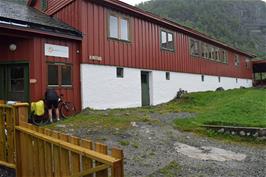
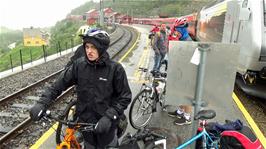

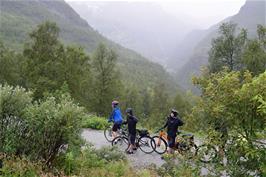
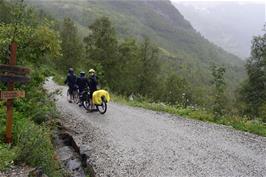
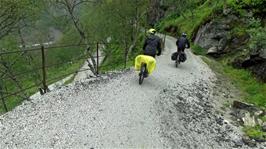
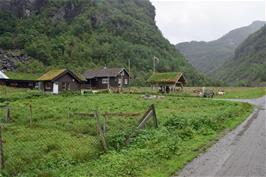
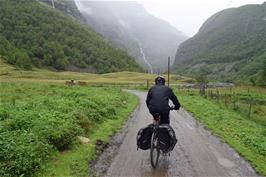
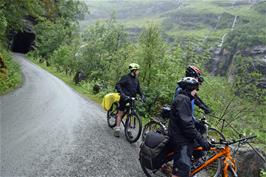
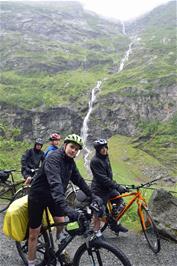
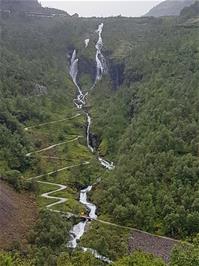
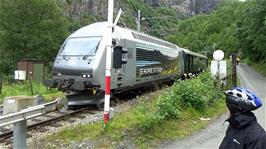
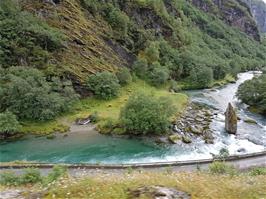
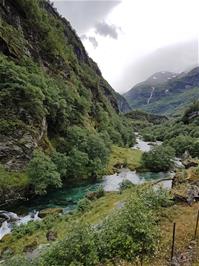
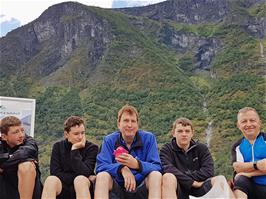
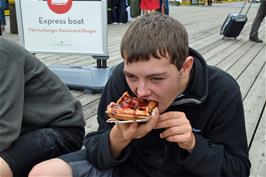
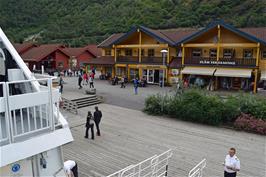
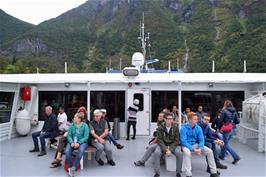
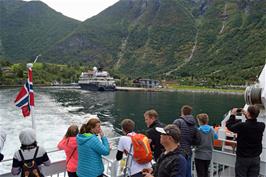
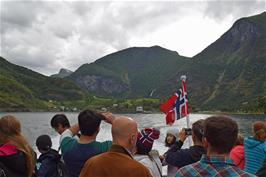
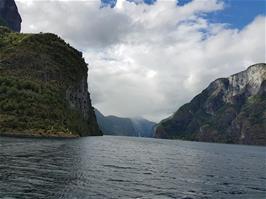
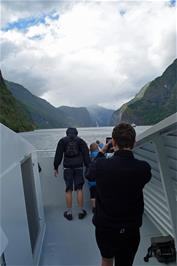
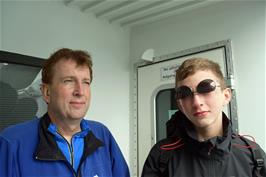
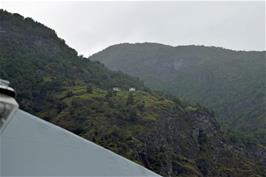

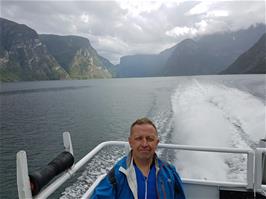
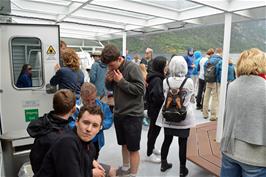
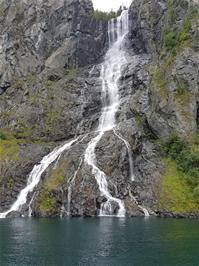
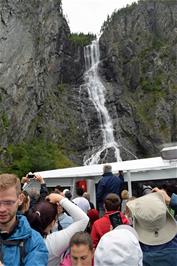
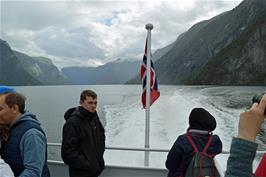
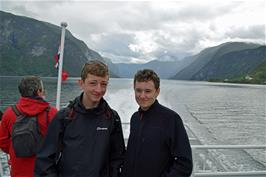
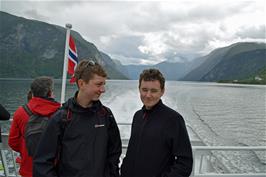
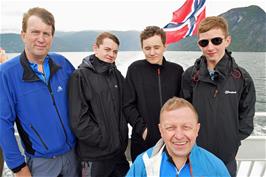
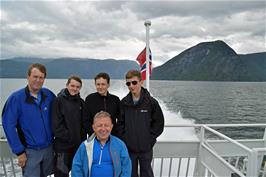
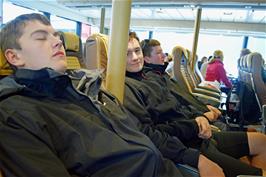
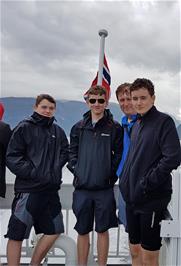
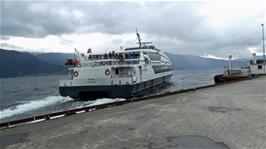
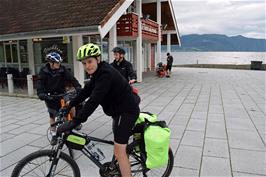
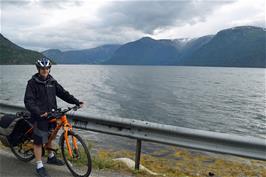
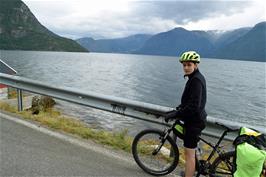

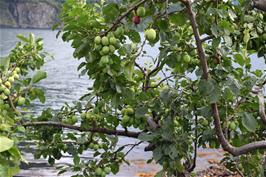
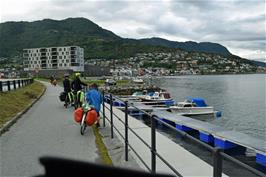




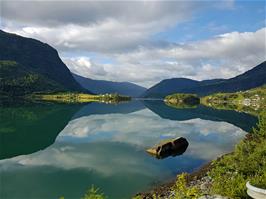
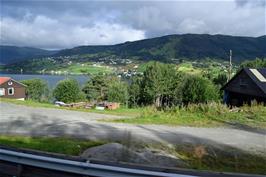

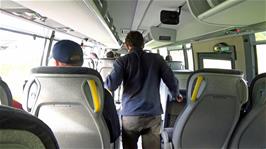
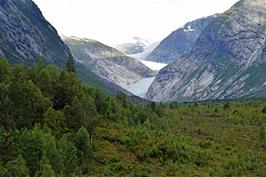
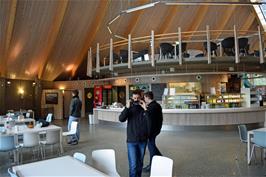

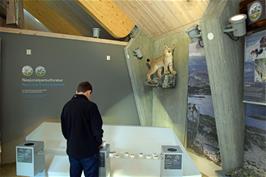

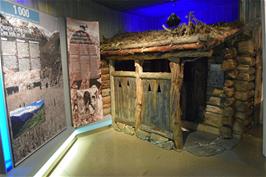
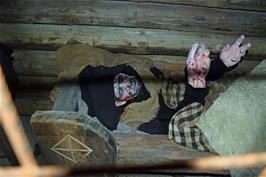
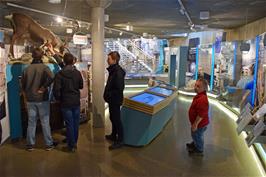

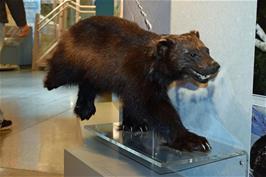
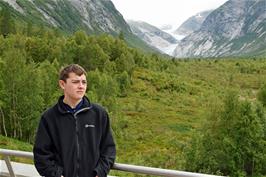

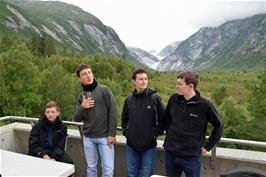
-ps.jpg)
